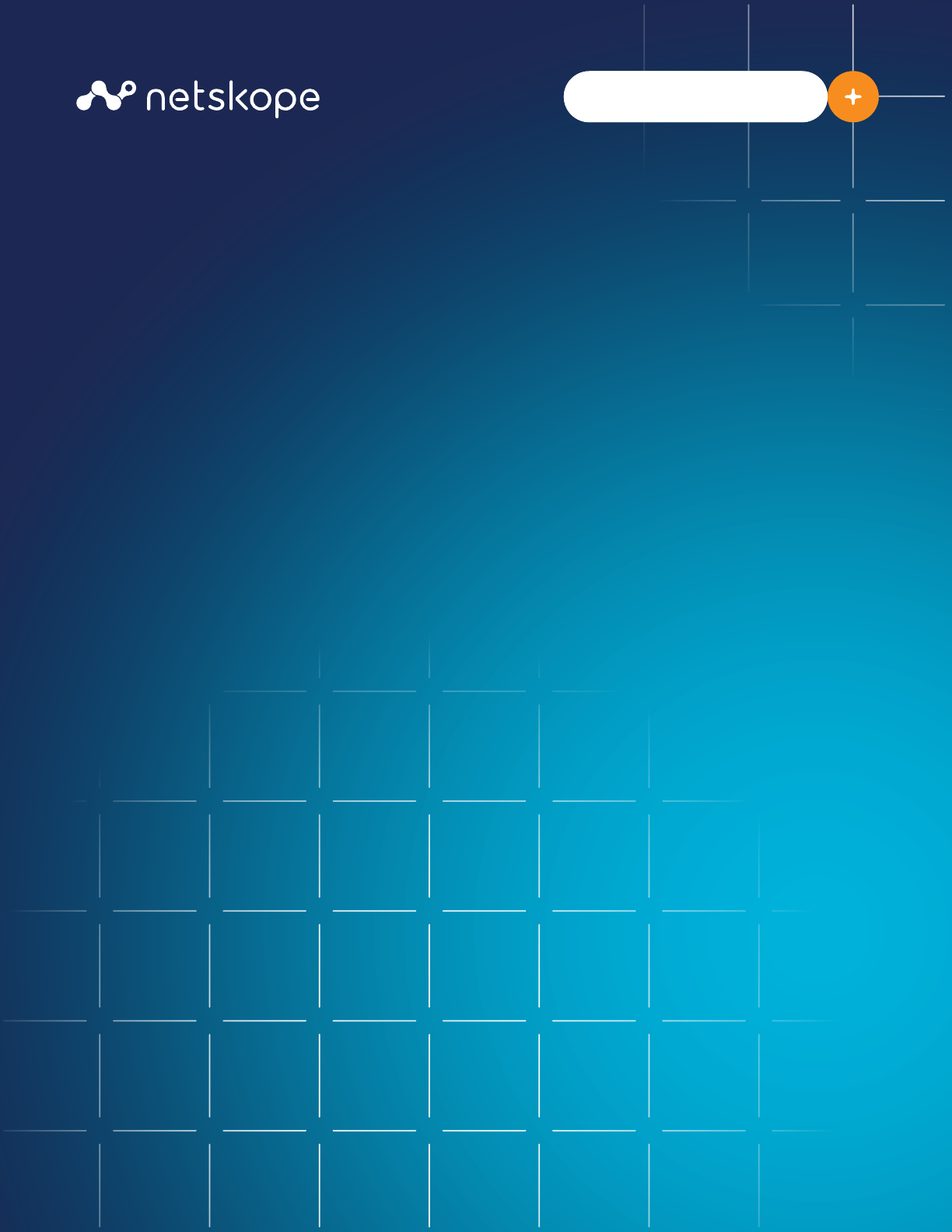
White PaperReference Architecture
Steering Traic through
Netskope Security
Service Edge

2
DOCUMENT SCOPE
This document is intended to give an Architecture and Best Practice overview of the Netskope Steering
in a single document. This document is intended for:
• Enterprise Architects
• Security and Network Architects
• Solution Architects
• CISO and InfoSec Team
• CIO and CTOs
This reference architecture will demonstrate:
• The different types of steering methods
• Use cases for each method
• The minimum requirements for each steering method
• How to interoperate within an existing proxy environment
Note: It is not intended to be used as a deployment and troubleshooting guide.
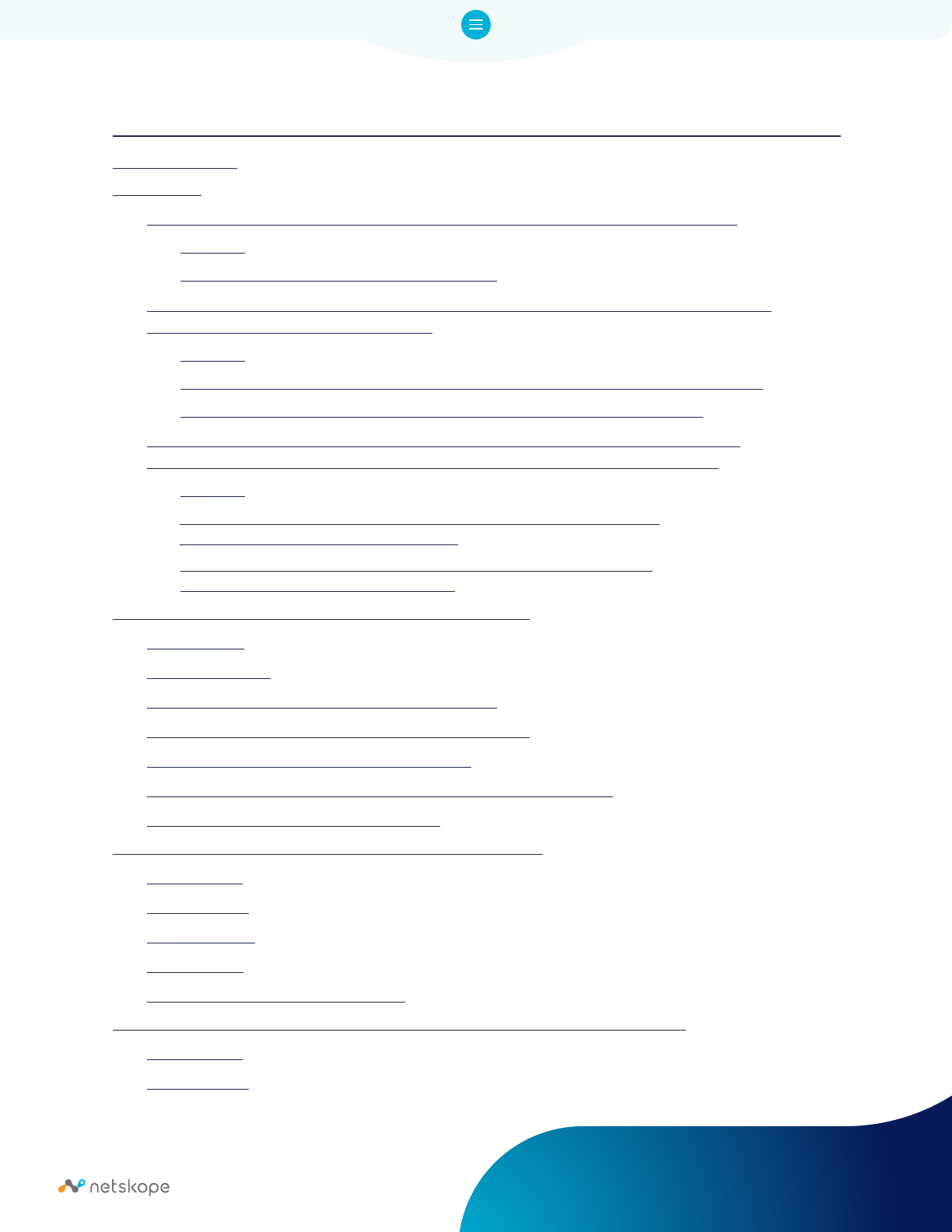
3
CONTENTS
INTRODUCTION 5
USE CASES 8
Use Case #1 - On-premises or Remote users with Corporate Managed Device 9
Overview 9
Recommended Architecture - Netskope Client 10
Use case #2 - On-premises users and devices (servers and IoT) where installation
of the Netskope Client is not feasible 12
Overview 12
Recommended Architecture - Steering Web and Non-web Apps via IPsec/GRE Tunnel 13
Recommended Architecture - Steering Web Apps Only via IPsec/GRE Tunnel 14
Use Case #3 - Remote user utilizing a personal device, including options like
Chromebook, where the installation of the Netskope Client is not possible 17
Overview 17
Recommended Architecture for Accessing Managed SaaS Web Apps -
Steering with Reverse Proxy as a Service 18
Recommended Architecture for Accessing Corporate Internet Apps -
Steering with Cloud Explicit Proxy (CEP) 19
TRAFFIC STEERING METHOD WITH NETSKOPE CLIENT 22
When to Use 22
Netskope Client 23
Netskope Client - Connectivity Requirements 23
Netskope Client - Automatic Data Plane Selection 24
Netskope Client - Steering Conigurations 27
Netskope Client - Interoperability with 3rd party VPN clients 28
Beneits of deploying Netskope Client 29
TRAFFIC STEERING METHOD WITH NETWORK TUNNELS 32
When to use 32
Prerequisites 33
IPSec Tunnels 33
GRE Tunnels 34
Policy Based Forwarding/Routing 35
TRAFFIC STEERING METHOD WITH EXPLICIT PROXY OVER TUNNEL EPOT 36
When to use 36
Prerequisites 36
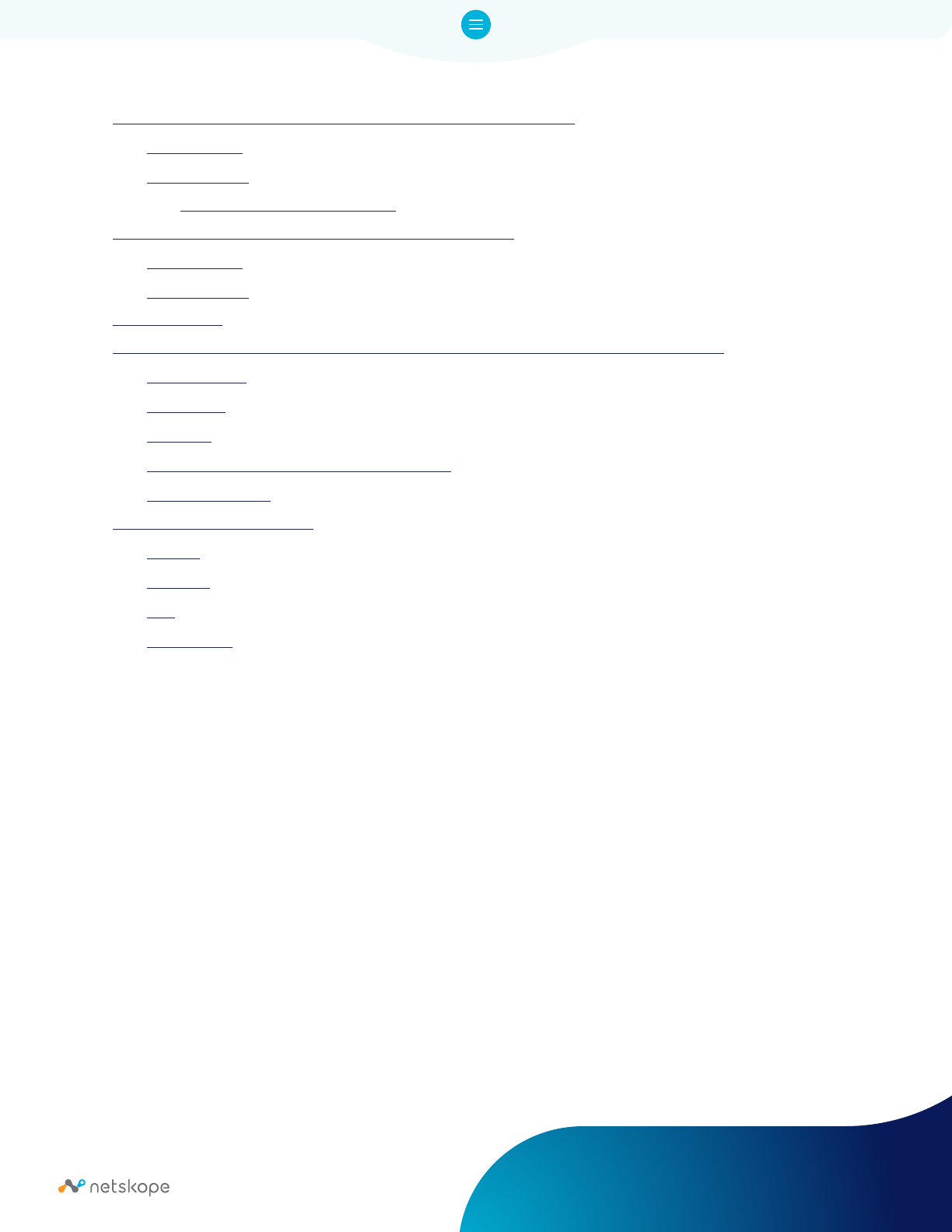
4
TRAFFIC STEERING METHOD WITH CLOUD EXPLICIT PROXY 38
When to use 38
Prerequisites 38
Support for ChromeOS devices 40
TRAFFIC STEERING METHOD WITH REVERSE PROXY 40
When to use 40
Prerequisites 40
CONCLUSION 41
APPENDIX 1 DEDICATED EGRESS IP ADDRESS SOURCE IP ADDRESS PINNING 42
Requirement 42
Challenge 42
Solution 42
Overview of Dedicated Egress IP (DEIP) 43
Beneits of DEIP 44
ADDITIONAL RESOURCES 44
Videos 44
Training 44
Lab 44
Addendum 44
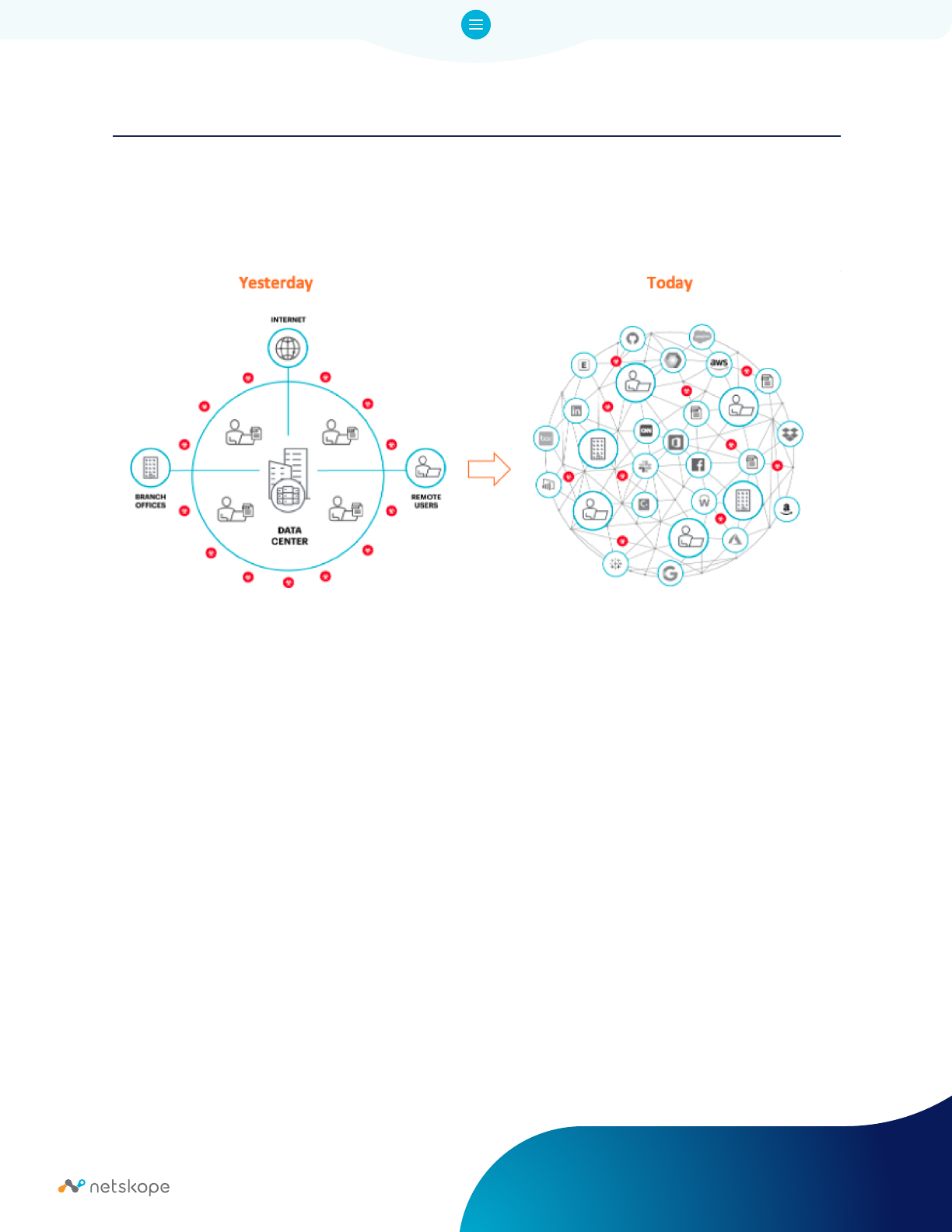
5
INTRODUCTION
The ever-changing landscape
All organizations - small, medium and large have witnessed the shift in how their application services
were and are being delivered to their users. The shift is happening across all facets - applications, users,
user locations, and end points used to access these applications.
Applications that were primarily hosted in the data centers are now spread across - data centers, public
clouds and some applications are consumed as Software-as-a-Service.
Users could be employees, contractors, customers, business partners, auditors, etc.
Servers and IoT devices are also endpoints other than users that access application services
on the Internet.
Location and Endpoints - Traditionally corporate applications were accessible from internal corporate
networks or remotely over a virtual private network from a corporate managed endpoint. However,
today’s business demands that applications be accessible from anywhere using any device be it a
corporate managed device or their personal device.
We are currently experiencing a rapid transformation, anticipating a continuous rise in the number of
users operating in a hybrid environment. There is a noticeable trend towards the widespread use of
personal or unmanaged devices for accessing corporate applications. Additionally, application services
are increasingly proliferating across the cloud and SaaS platforms.
In order to intelligently analyze each user request to an application service, the crucial element we
require is "context." Obtaining context is essential in terms of understanding and effectively responding
to user interactions, there are four key components that are required to provide context:
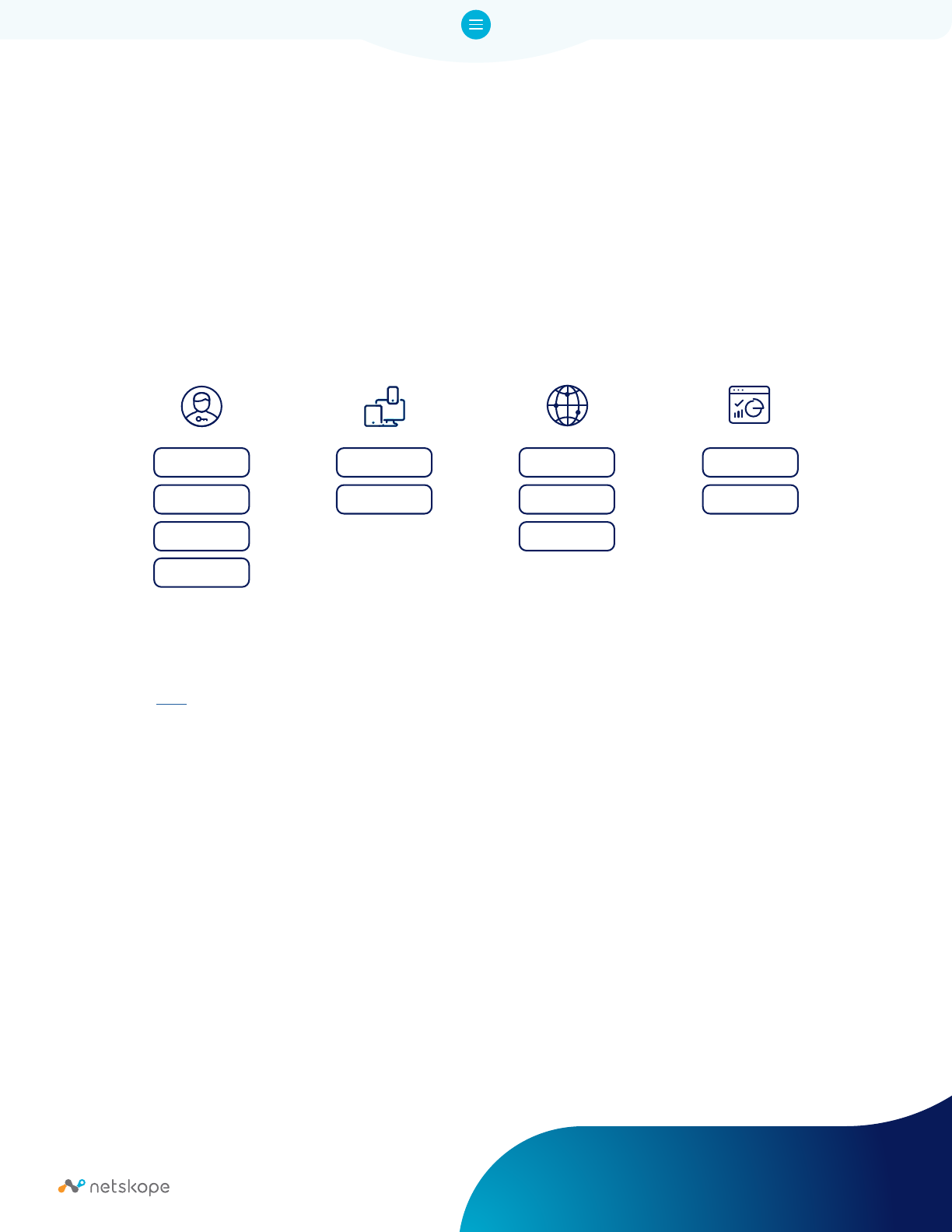
6
• WHO - is it an employee or a contractor or is it from another application service or from
an IoT device.
• HOW - is it a trusted (managed) device or an untrusted (unmanaged) device.
• WHERE - is the application services accessed from Public Internet or Internal network
and inally
• WHAT - Determining which speciic application service is being accessed and identifying
the speciic actions being performed — such as View, Create, Edit, Copy, Move, Share, Delete,
Comment, etc.— is essential for a comprehensive understanding of the user's interactions.
Note: This reference architecture covers the use cases where trafic is steered to the Internet. Use cases
for steering trafic to internal private applications are covered in detail in the ZTNA reference architecture
guide here.
The challenge
Organizations have grappled with the myriad challenges posed by legacy on-premises solutions,
including issues related to scalability during unexpected peaks or growth, resiliency concerns,
increased data center footprint, the burden of hardware and software maintenance, and associated
overheads. Notably, these challenges often translate into heightened Total Cost of Ownership (TCO)
and occasionally yield suboptimal Return on Investment (ROI).
Moreover, the inlexibility of the architecture in legacy on-premises solutions falls short in meeting
evolving security requirements. Any workarounds implemented to address this shortfall typically
result in a compromised user experience or, worse, lead to unplanned downtimes.
WHO
Employee
H OW
WHERE WHAT
Contractor
Server/IoT
Internal
Internet
All Web
Private Apps
Hyrbid
Others
Managed
Unmanaged
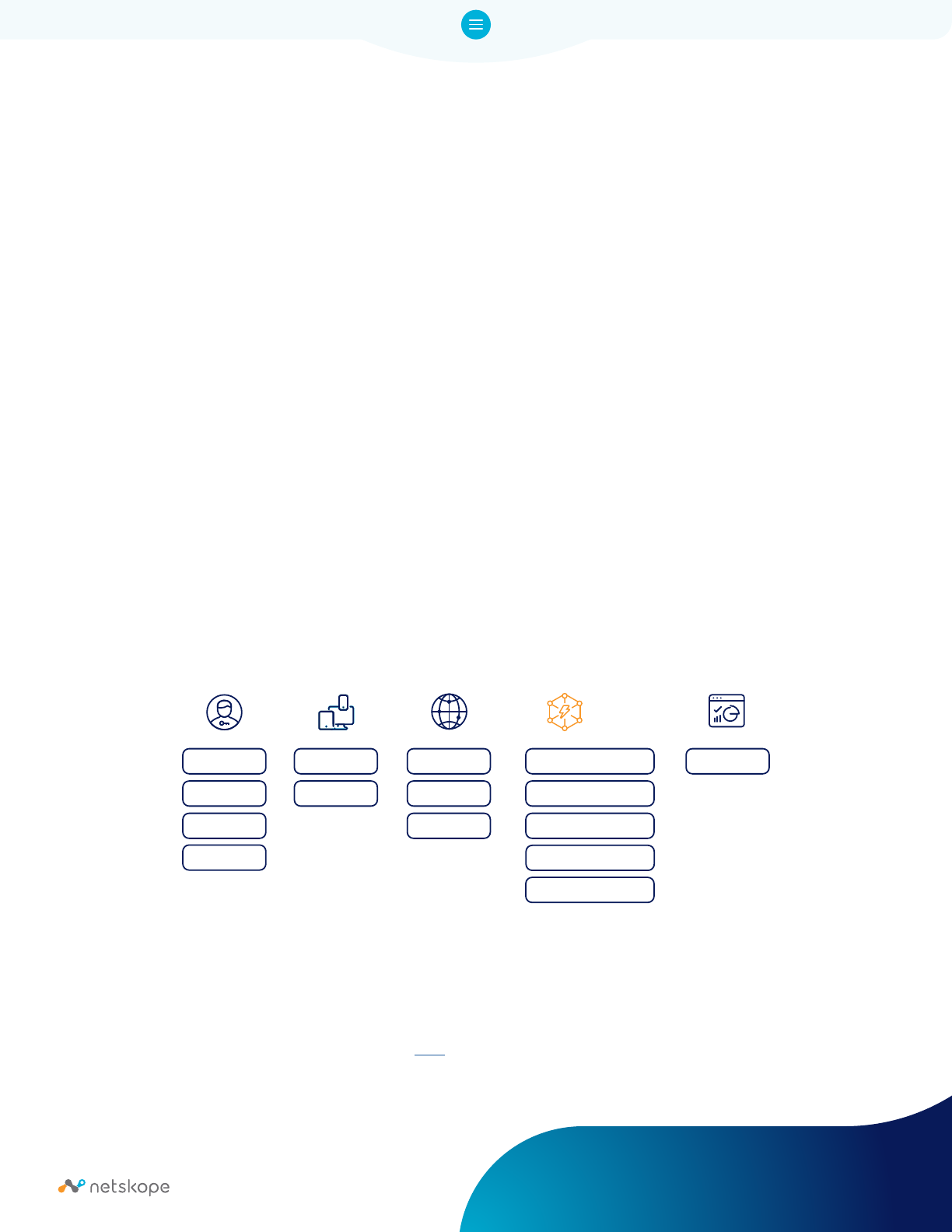
7
Recognizing these drawbacks, organizations have come to acknowledge that a cloud-based Secure
Services Edge (SSE) represents the optimal solution capable of addressing both current challenges
and accommodating future growth seamlessly.
For a seamless integration of a cloud-based SSE solution, it is essential that the solution offers lexible
mechanisms for eficiently directing (“steering”) trafic to the Secure Services Edge (SSE):
• From any user.
• From wherever the user is.
• From whichever device they use and.
• To whatever application they access.
This is where Netskope, the leader in Gartner’s Magic Quadrant for SSE solutions, leads the way in
supporting lexible trafic steering methods to meet the different use cases of our customers.
Depending on the use case, customers can choose from a variety of steering solutions, such as:
• Netskope Steering Client. The Netskope Steering Client is a lightweight non-intrusive steering
client that provides the most comprehensive control and visibility. It steers trafic from the
endpoint, to the closest Netskope NewEdge Data Plane, regardless of the device location.
• Network Tunnel. When a Netskope Client cannot be installed, steering trafic from on-premises or
public cloud endpoints to Netskope NewEdge Data Planes can be achieved with a Network tunnel.
• Explicit Proxy. Legacy or regulated environments where an Explicit Proxy needs to be conigured,
trafic can be steered using Explicit Proxy over Tunnel, Cloud Explicit Proxy or Proxy
Chaining options.
In this Reference Architecture Guide, we will comprehensively explore a range of real-world use cases
spanning diverse industry verticals. Netskope provides robust trafic steering mechanisms to adeptly
handle and navigate through these various scenarios.
We will not cover user access to private applications, this is extensively covered in the ZTNA
Next reference architecture guide available here.
WHO
Employee
HOW
WHERE
STEERING
SOLUTION
WHAT
Contractor
Server/IoT
Internal
Netskope
NewEdge
Internet
All Web
Hyrbid
Client
IPSEC/GRE
Explicit Proxy over Tunnel
Cloud Explicit Proxy
Reverse Proxy
Others
Managed
Unmanaged

8
USE CASES
In the contemporary hybrid landscape, we can broadly categorize use cases based on whether the user
is on-premises or remote, and further, if the user is accessing application services through a device with
the Netskope client installed or not. Additionally, there's a potential scenario where the trafic originates
from a non-user endpoint, such as a server or an IoT device.
Taking the aforementioned factors into account, the use cases elaborated upon in this reference
architecture guide include:
• Use Case #1 - On-premises or Remote users with Corporate Managed Device.
• Use Case #2 - On-premises users and devices (servers and IoT) where installation of the Netskope
Client is not feasible.
• Use Case #3 - Remote user utilizing a personal device, including options like Chromebook, where
the installation of the Netskope Client is not possible.
In this reference architecture, we are not covering two corner use cases:
1. Explicit Proxy over Client (EPoC) - this steering method is used in cases where, in the internal
corporate network, there is no default gateway and the endpoint cannot resolve no public FQDNs.
2. Proxy Chaining (PXC) - this steering method is considered in cases where users need to egress to
the Internet using two or more speciic proxies.
Now, let's delve into a detailed exploration of these use cases.
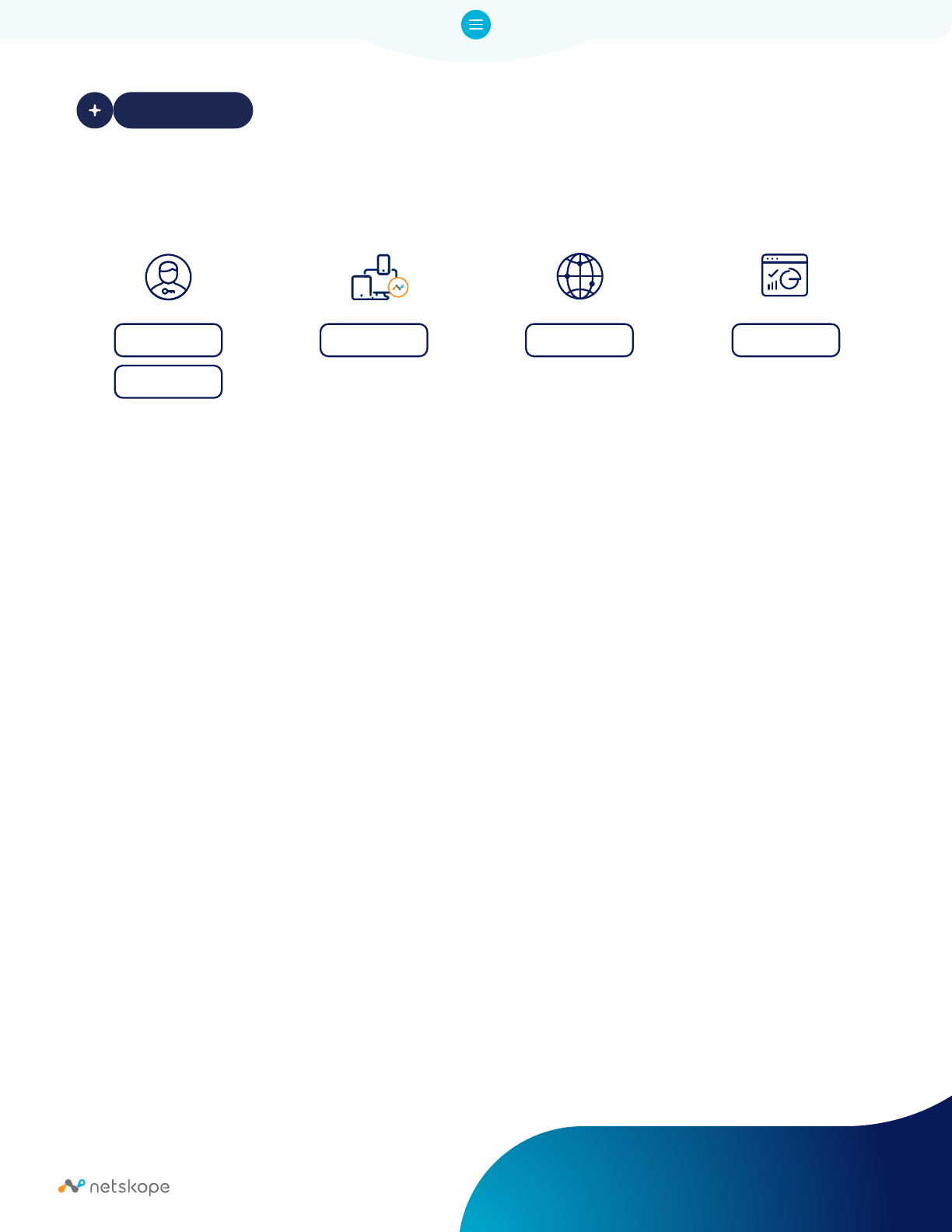
9
Use Case 1
Overview
For this use case as depicted in the diagram above, we consider that:
(Who) Users can be an employee or contractor.
(How) Endpoint used by the user on which Netskope client can be installed. These can be corporate
or personal devices managed by an Endpoint Management Solutions.
(Where) Location of the user is on-premises.
(What) Applications accessed by the user can be any application on the Internet. It could be general
web,cloud applications or SaaS.
On-premises or Remote users
with Corporate Managed Device
WHO
Employee
HOW
WHERE WHAT
Contractor
On-Prem All WebAny
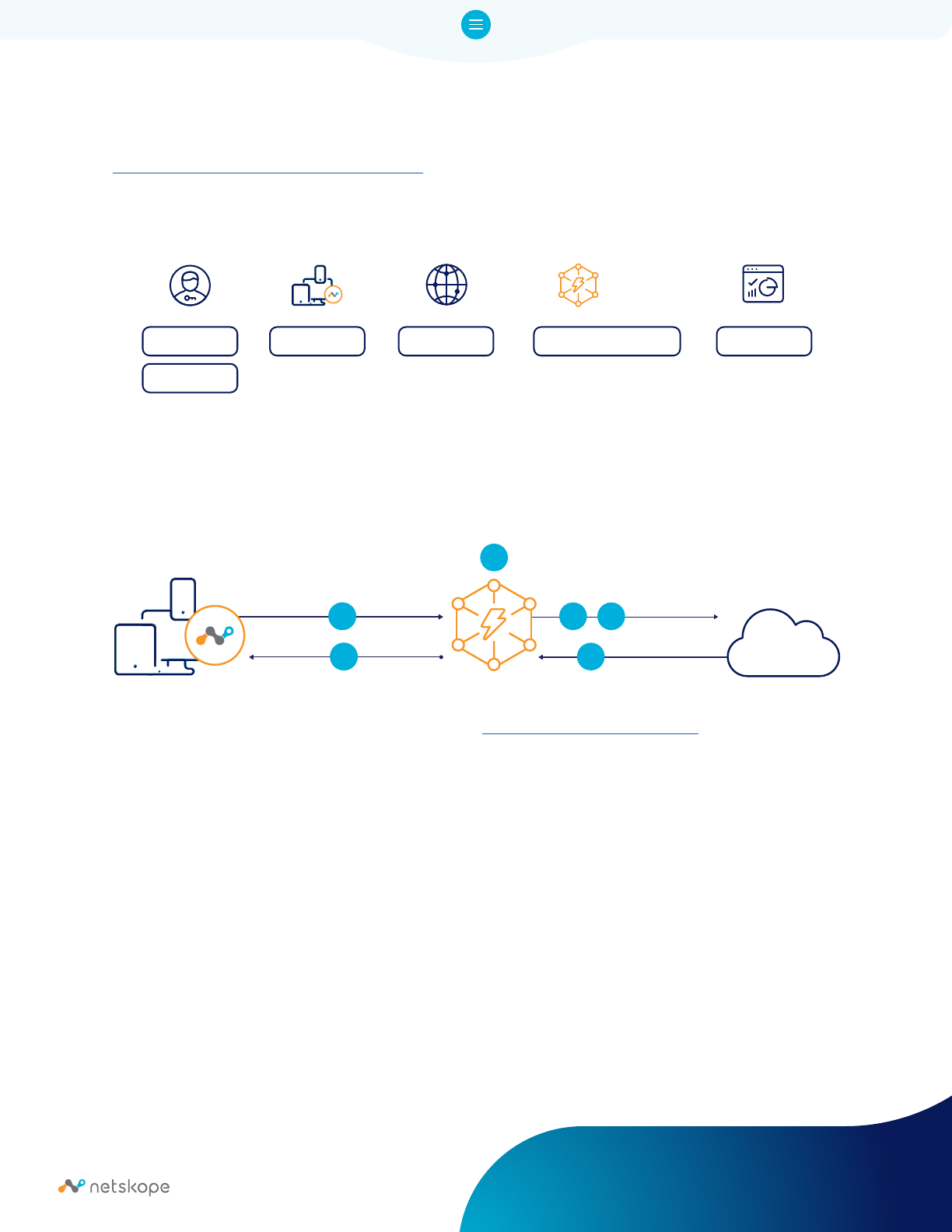
10
Recommended Architecture - Netskope Client
For this use case, we recommend “Netskope Client”. Details on this architecture, please refer to Chapter
Trafic Steering Method with Netskope Client. In this architecture, the endpoint has the Netskope Client
installed which connects to the closest Netskope NewEdge Data Plane.
All internet trafic, both web and non-web egressing from the endpoint, and not explicitly bypassed, is
steered to Netskope NewEdge Data Plane. On the NewEdge Data Plane, the trafic is inspected based on
the real-time security policies deined and the corresponding action is taken.
Trafic Flow to Internet Apps
1. Endpoint with Netskope client connects to the closest Netskope NewEdge Data Plane, for more
details on Data Plane selection, please refer to “Automatic Data Plane Selection”. All web and
non-web trafic to the Internet is steered from the endpoint to the closest Netskope NewEdge
Data Plane.
2. Trafic is inspected against the real time security policies deined.
3. Allowed trafic is forwarded from Netskope NewEdge Data Plane to the original destination.
on the Internet.
4. Trafic will egress the Netskope NewEdge Data Plane with the shared Netskope IP address range.
If the customer desires to egress with a dedicated IP address, then Dedicated Egress IP Address
services can be provisioned.
5. Response trafic from the Internet will be destined to Netskope NewEdge Data Plane, which will be
inspected before being forwarded to the endpoint.
WHO
Employee
H OW
WHERE
STEERING
SOLUTION
WHAT
Contractor
On-Prem
Netskope
NewEdge
All Web
Netskope Client
Any
1
2
5
1
5
3 4
5
Web/SaaS

11
Pre-requisites
1. Netskope Client installed on the endpoint.
2. Endpoint should be able to resolve *.goskope.com FQDNs and have reachability to Netskope
IP address ranges.
3. Firewall needs to allow direct access to Netskope domains on protocol HTTPS without SSL
interception (authentication should be disabled as well).
Beneits
1. Simple architecture.
2. Consistent security posture regardless of the user location.
3. Seamless deployment and operation.
4. Comprehensive trafic inspection, encompassing both web and non-web, directed towards both
Internet and Private Applications, originating from the endpoint.
5. Optimal Performance facilitated by the Netskope client's connection to the nearest Netskope
NewEdge Dataplane.
6. Unmatched visibility into all types of trafic—web and non-web, directed to both Internet and
Private Applications.
7. Uniied management through a single pane for all trafic, covering both web and non-web,
targeted towards both Internet and Private Applications, departing from the endpoint.
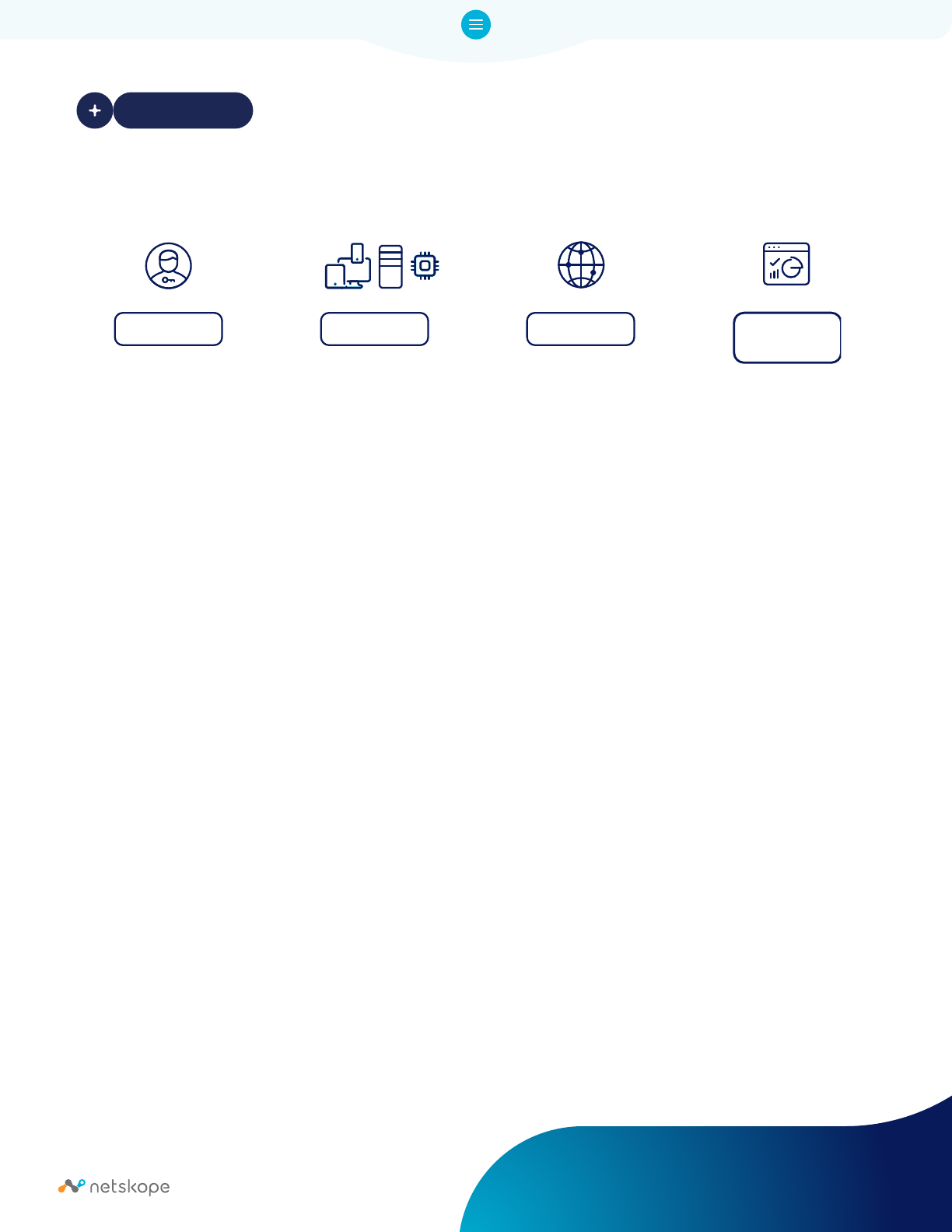
12
Use Case 2
On-premises users and devices (servers and IoT)
where installation of the Netskope Client is not feasible
Overview
For this use case as depicted in the diagram above, we consider that:
(Who) User is an employee or contractor.
(How) Endpoint used by the user is a device on which Netskope client cannot be installed.
Several examples can be provided:
• The organization has embraced Bring Your Own Device (BYOD) strategy.
• User/device connected to the Guest Wii/Network.
• Server or IoT devices which don’t allow Netskope client installation.
(Where) Location of the user is on-prem.
(What) Applications accessed by the user can be any web or non-web application on the Internet.
Note: In the scenario where the user is on-premises with an untrusted endpoint, the ideal approach
involves blocking access to internal private applications locally. In this speciic use case, only trafic
directed towards Internet Apps is taken into consideration.
WHO
Any
HOW
WHERE WHAT
On-Prem Internet
Web/Non-Web
Any
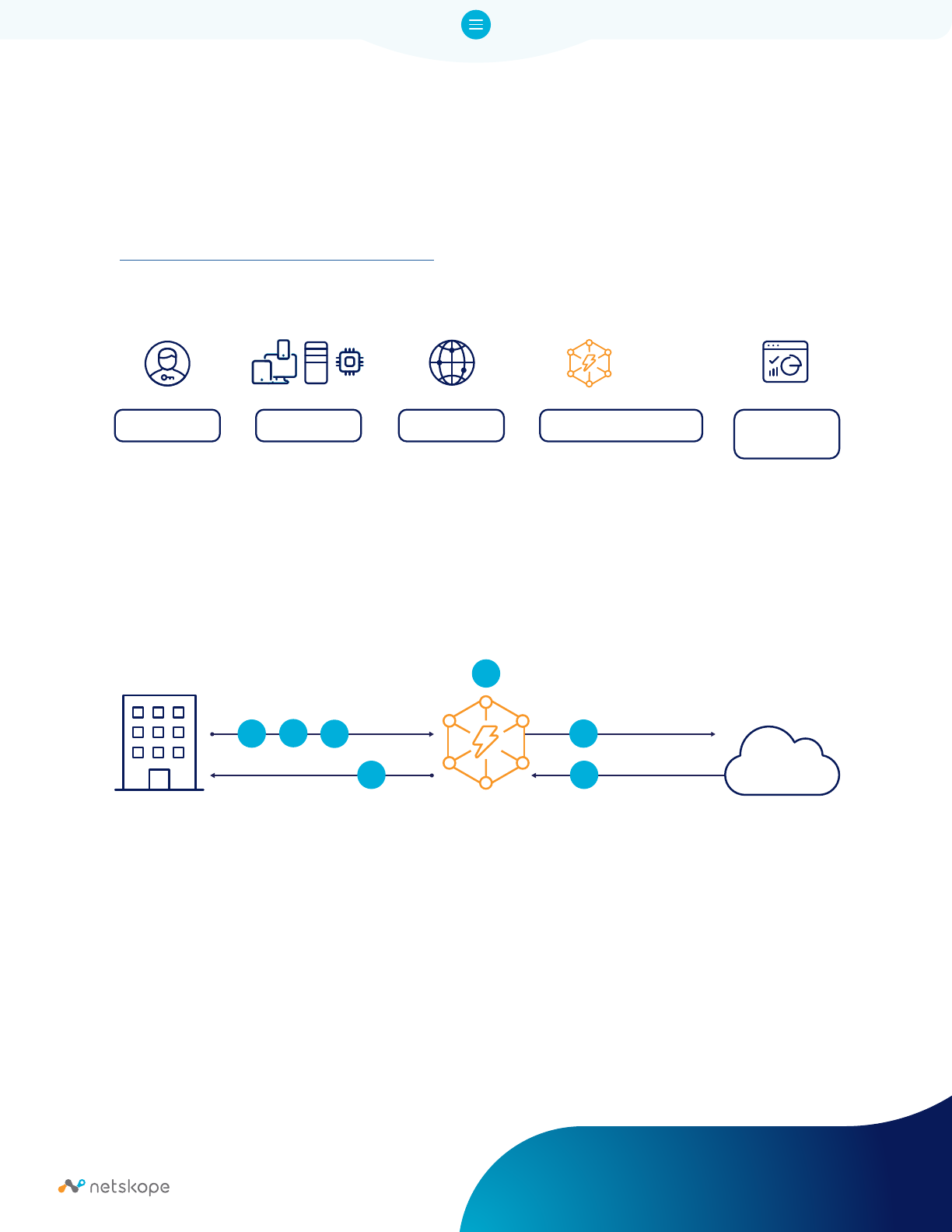
13
Recommended Architecture - Steering Web and Non-web Apps via IPsec/GRE Tunnel
All trafic, both web and non-web, needs to be steered from the on-premise endpoint to Netskope
NewEdge Data Plane. Since the endpoints do not have Netskope Client installed they cannot connect
to the Netskope NewEdge Data Plane directly. Hence, we connect the speciic network segment or the
entire site to the Netskope NewEdge Data Plane via a GRE or IPsec tunnel from any capable customer
premise equipment (CPE), more details on Network Tunnel steering can be found in chapter
“Trafic Steering Method with Network Tunnels”.
In this use case, to steer the trafic from the endpoint to the tunnel, the network administrator needs to
conigure policy based forwarding/routing techniques, wherein speciic routes are deined based on the
destination port and destination IP address.
Trafic Flow to Internet Web and Non-web Apps via Tunnel
1. As a prerequisite.
a. One or more GRE/IPSEC tunnels are conigured from each site to Netskope NewEdge Data Plane.
We recommend at least two tunnels to different Netskope NewEdge Data Planes for resiliency.
a. Policy based forwarding/routing policies are deined on the internal network, that route trafic
destined to the Internet towards the GRE/IPSEC tunnel established with Netskope NewEdge
Data Plane.
2. All web and non-web trafic to the Internet from the endpoint will be steered to Netskope NewEdge
Data Plane over the GRE/IPSEC tunnel.
WHO
Any
HOW
WHERE
STEERING
SOLUTION
WHAT
On-Prem
Netskope
NewEdge
Tunnel - GRE/IPSEC
Any
Internet
Web/Non-Web
3
5
1a
1b
2
4
5
Web/
Non-Web
Site

14
3. Allowed trafic is forwarded from Netskope NewEdge Data Plane to the original destination
on the Internet.
4. Trafic will egress the Netskope NewEdge Data Plane with the shared Netskope IP address range.
If the customer desires to egress with a dedicated IP address, then Dedicated Egress IP Address
services can be provisioned.
5. Response trafic from the Internet will be destined to Netskope NewEdge Data Plane, which will be
inspected before being forwarded to the endpoint.
Note: It is possible to enforce User SAML authentication and SSL inspection only if the Netskope Root
and Intermediate Certiicate bundle can be installed on the endpoints.
Pre-requisites
1. One or more GRE/IPSEC tunnels are conigured from each site to Netskope NewEdge Data Plane.
We recommend at least two tunnels to different Netskope NewEdge Data Planes for resiliency.
2. Policy based forwarding/routing policies are deined on the internal network, that route trafic
destined to the Internet towards the GRE/IPSEC tunnel established with Netskope NewEdge
Data Plane.
Beneits
1. Best suited for endpoints on which Netskope Client cannot be installed.
2. Comprehensive trafic inspection of all trafic, both web and non-web, and to the Internet.
3. Visibility of Private IP of the user, allowing advanced logging and IP-based access policies, in case
authentication is not an option.
Recommended Architecture - Steering Web Apps Only via IPsec/GRE Tunnel
When it is not possible to conigure policy based forwarding/routing techniques, Explicit Proxy can be
deined on the endpoints, and Explicit Proxy over Tunnel (EPoT) steering method can be used for Internet
Web Apps only.
Also, for large environments that use PAC iles deployed on endpoints, and want to continue using it
for the large number of exceptions that are already scripted into the PAC ile, Explicit Proxy over Tunnel
(EPoT) steering method can be used.
Note: EPoT does not support Internet based non-web applications.
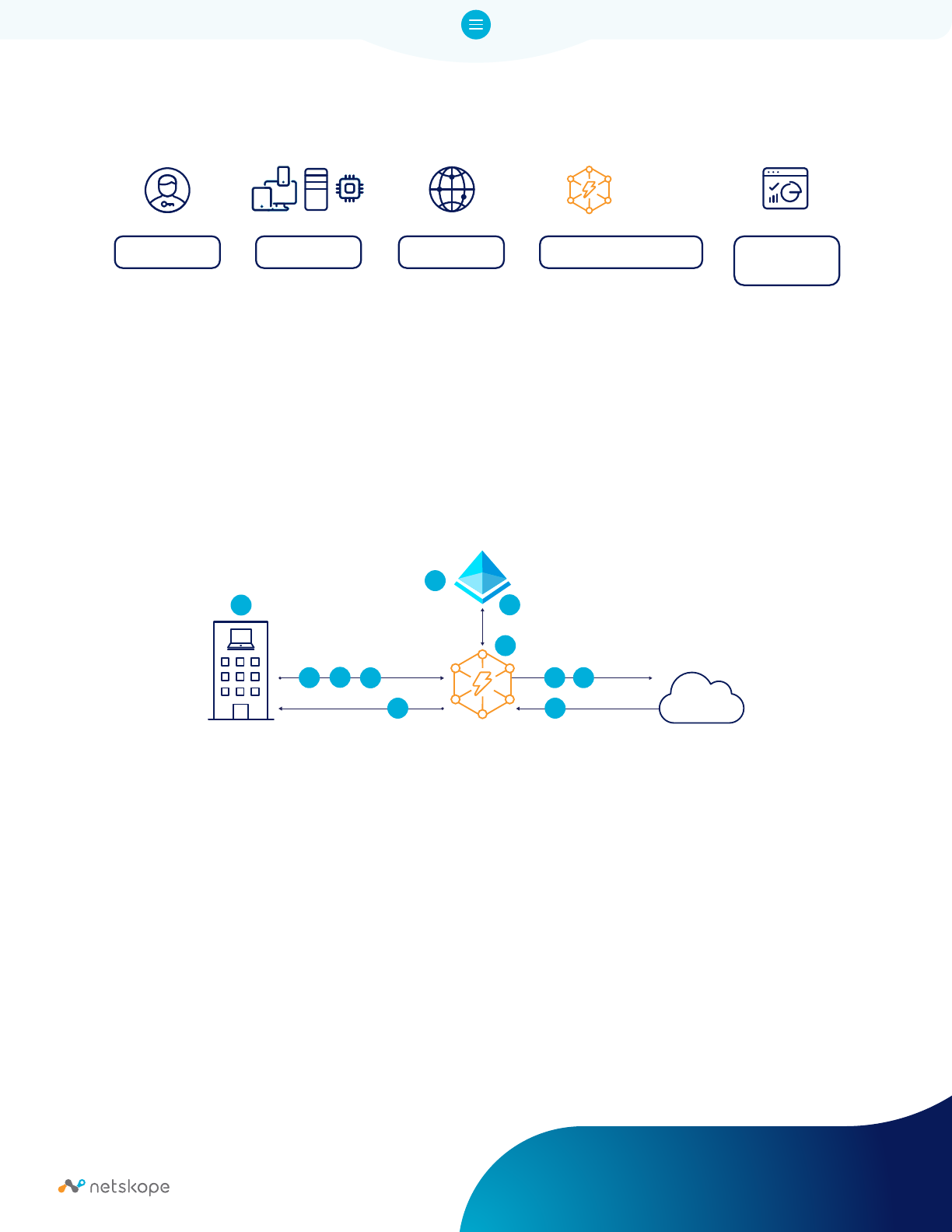
15
The explicit proxy coniguration can point HTTP/HTTPS trafic to one of the reserved IP addresses
163.116.128.80 or 163.116.128.81 on port 8080, either manually or using a PAC ile.
We will need to conigure policy based forwarding/routing to route the trafic from the endpoint destined
to the EPoT IP addresses over the tunnel.
Note: EPoT only supports ports 80, 443, and 8080.
Trafic Flow to Internet Web Apps via EPoT
1. As a prerequisite.
a. One or more GRE/IPSEC tunnels are conigured from each site to Netskope NewEdge Data Plane.
We recommend at least two tunnels to different Netskope NewEdge Data Planes for resiliency.
b. On the endpoints at the site, trafic needs be steering to Netskope reserved EPoT IP addresses
163.116.128.80 or 163.116.128.81 on port 80. This can be achieved with explicit proxy conigured
directly on the endpoint or PAC ile.
b. SAML based Identity Provider (IdP) for authenticating the user.
2. All web trafic to the Internet destined on port (80, 443 and 8080) from the endpoint will be
steered to the Netskope Proxy over the GRE/IPSEC tunnel which terminates at the Netskope
GRE/IPSEC headend.
WHO
Any
HOW
WHERE
STEERING
SOLUTION
WHAT
On-Prem
Netskope
NewEdge
Explicit Proxy over Tunnel
Any
Internet
Web Only
3
4
1c
7
1a
1b
1b
2
5 6
7
Web/SaaS
SAML IdP
Site

16
3. User authentication against the deined SAML IdP.
Note: There could be scenarios like (server initiated trafic, trafic from IoT devices), where
authenticating against SAML IdP might not be feasible. For such scenarios, Netskope provides the
option to bypass authentication based on the source IP address, which would be static or from a
predeined internal IP range.
4. Netskope Proxy sees the incoming HTTP request on port 8080. Trafic is inspected against the real
time security policies deined.
5. Allowed trafic is forwarded from Netskope NewEdge Data Plane to the original destination
on the Internet.
6. Trafic will egress the Netskope NewEdge Data Plane with the shared Netskope IP address range.
If the customer desires to egress with a dedicated IP address, then Dedicated Egress IP Address
services can be provisioned.
7. Response trafic from the Internet will be destined to Netskope NewEdge Data Plane, which will be
inspected before being forwarded to the endpoint.
Pre-requisites
1. One or more GRE/IPSEC tunnels are conigured from each site to Netskope NewEdge Data Plane.
We recommend at least two tunnels to different Netskope NewEdge Data Planes for resiliency.
2. Policy based forwarding/routing policies are deined on the internal network, that route web trafic
destined to the reserved EPoT IP addresses 163.116.128.80 or 163.116.128.81 on port 8080
towards the GRE/IPSEC tunnel established with Netskope NewEdge Data Plane.
3. SAML based Identity Provider (IdP) for authenticating the user.
4. Netskope certiicate bundle needs to be trusted on the endpoints.
Beneits
1. Best suited for endpoints on which Netskope Client cannot be installed.
2. EPoT can work with legacy environments using PAC iles.
3. Comprehensive trafic inspection of all trafic, both web and non-web, and to the Internet using
tunnels. Inspection of web trafic to Internet, when using EPoT.
4. Visibility of Private IP of the user, allowing advanced logging and IP-based access policies, in case
authentication is not an option.
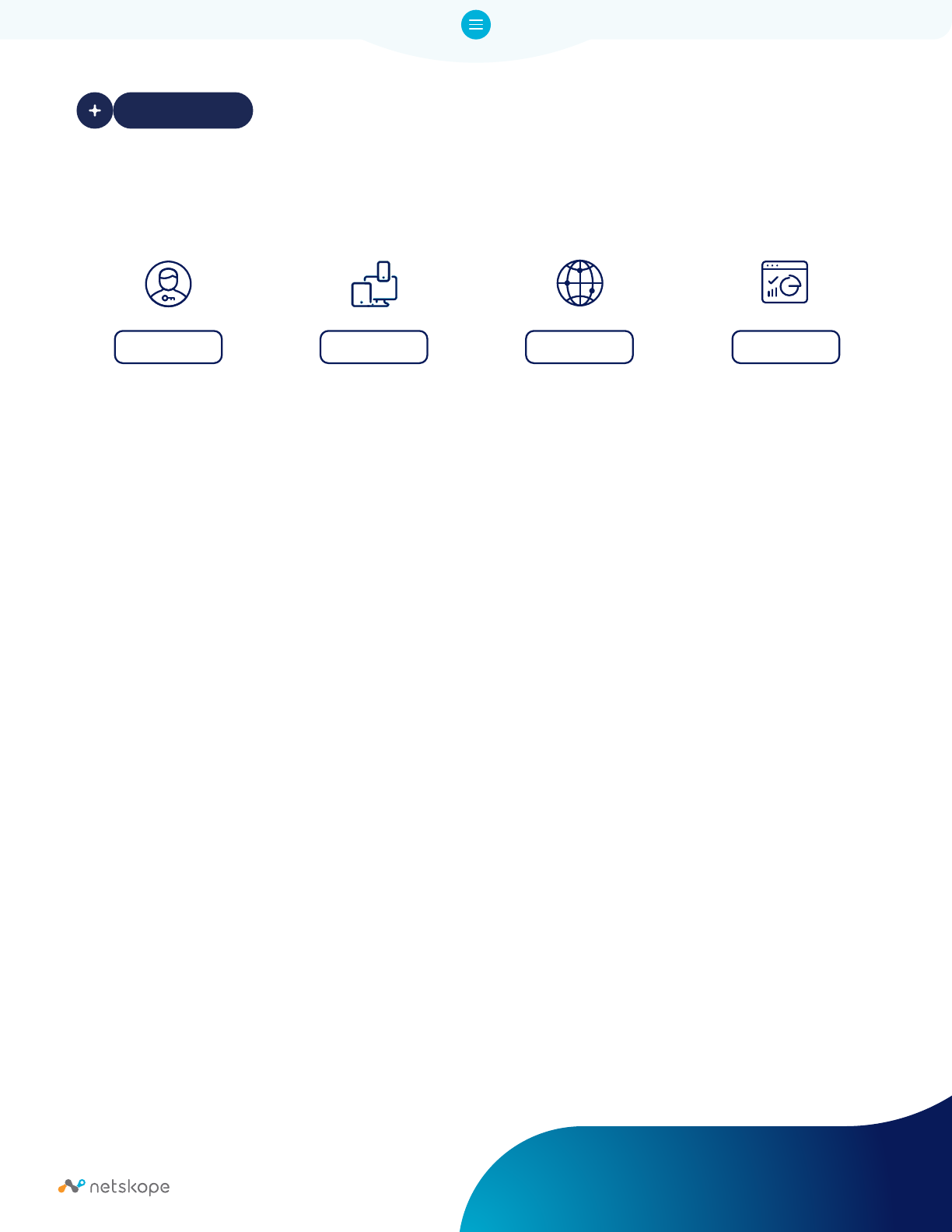
17
Overview
For this use case as depicted in the diagram above, we consider the:
(Who) Users can be an employee or contractor.
(How) Endpoint used by the user is a device on which Netskope client cannot be installed. For example, it
could be an employee working remotely from their personal device, it could be a contractor or auditor or
business partner using their organization issued endpoint, and needs access to Internal applications.
(Where) Location of the user is remote.
(What) Applications accessed by the user can be a web based internet application or a SaaS application.
Use Case 3
Remote user utilizing a personal device, including options
like Chromebook, where the installation of the Netskope
Client is not possible
WHO
Employee
HOW
WHERE WHAT
Remote Managed SaasUnmanaged
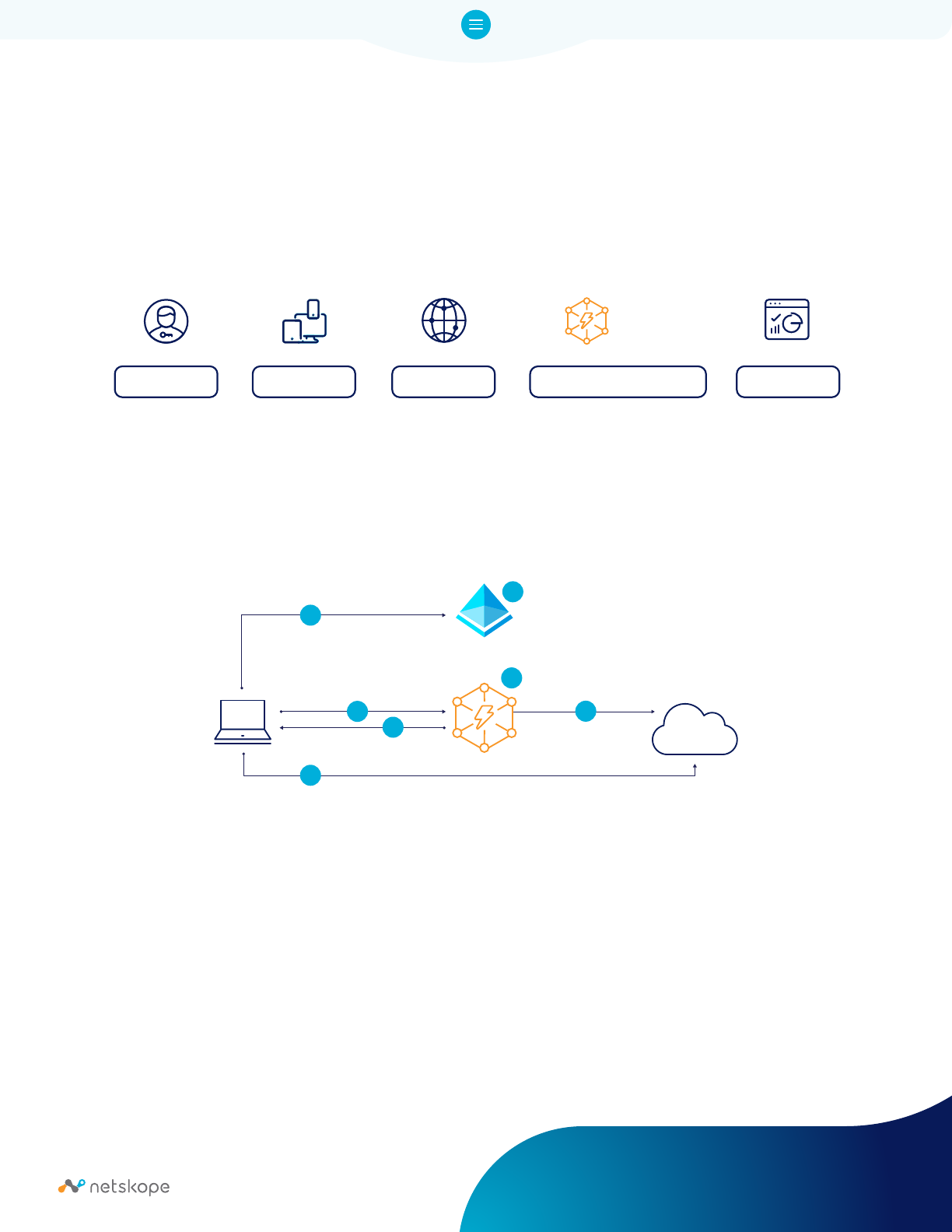
18
Recommended Architecture for Accessing Managed SaaS Web Apps -
Steering with Reverse Proxy as a Service
Today organisations consume many managed SaaS applications that could be accessed from the public
Internet. But organisations would like to restrict the access to allow access from only trusted sources (like
Netskope IP ranges or Dedicated Egress IP Address services) post authentication.
Netskope provides a reverse proxy deployment mode that steers browser-based cloud trafic from
managed cloud apps to the Netskope Security Cloud. This deployment option is required for covering
unmanaged devices that are off network accessing managed cloud apps.
Trafic Flow to Managed SaaS Web Apps via Reverse Proxy as a Service
1. User connects to the SaaS application.
2. SaaS application redirects the user to Netskope SAML Proxy.
3. Netskope SAML Proxy redirects the user to the deined SAML IdP.
4. User authenticates against the deined SAML IdP.
5. After successful authentication, user is redirected to Netskope SAML Proxy with the SAML Assertion.
6. Request will be inspected against the real time security policies deined to determine if the
trafic needs to be proxied by Netskope Reverse Proxy or bypassed (direct) or blocked to the
SaaS application.
7. If the request needs to be proxied, the user will be redirected to rproxy.goskope.com instead of
the SaaS application, and Netskope Reverse Proxy will proxy the request to the SaaS application.
WHO
Employee
HOW
WHERE
STEERING
SOLUTION
WHAT
Remote
Netskope
NewEdge
Managed SaasReverse Proxy as a ServiceUnmanaged
4
2
5
6
7
Managed
SaaS
3
1

19
Pre-requisites
1. SAML based Identity Provider (IdP) for authenticating the user.
2. Deine conditional access in the managed SaaS application to allow access Netskope IP ranges or
Dedicated Egress IP Address services.
3. Refer the below knowledge base for respective IdP and SaaS application https://docs.netskope.
com/en/netskope-help/proxies/.
Beneits
1. Real-time visibility and control for managed and unmanaged devices accessing managed
cloud apps.
2. Only deployment that covers unmanaged devices off network accessing managed cloud apps.
3. Browser trafic only – no native apps or sync clients.
Recommended Architecture for Accessing Corporate Internet Apps - Steering with Cloud Explicit
Proxy (CEP)
In a hybrid model, organisations need to expose applications that are hosted in their data centers or
on public clouds over the Internet. To reduce the attack surface, organisations would like to allow
access from only trusted sources (like Netskope IP ranges or Dedicated Egress IP Address services)
post authentication.
For such use cases, where we need to steer the web trafic from the remote endpoint to Netskope
NewEdge Data Plane, we recommend Netskope Cloud Explicit Proxy steering method. Please note that
this Cloud Explicit Proxy only supports web trafic, and is not supported with desktop or mobile thick/
native apps.
Steering of the web trafic is done via PAC ile. Once the PAC ile is downloaded, the web trafic from the
endpoint will be proxied via the cloud proxy service in the Netskope NewEdge Data Plane.
For enterprises that use managed Chromebooks and want these devices to also leverage the Netskope
NGSWG, Netskope provides a Chrome Extension that makes enabling and managing connections to
Cloud Explicit Proxy easier.
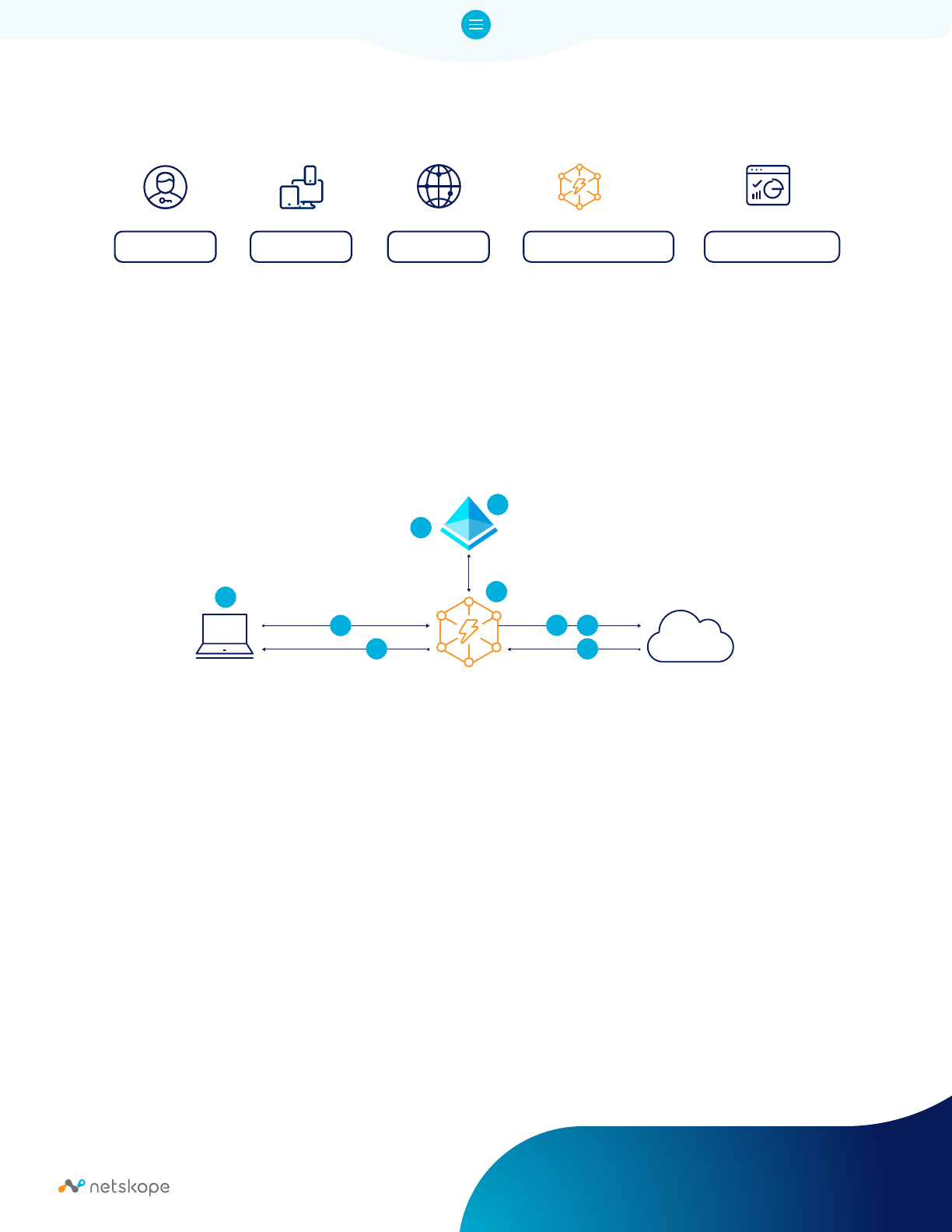
20
Currently, Netskope doesn’t host PAC iles, therefore customers who require to implement this use case
need to host the PAC ile in their environment.
In case the customer has a need to bypass Netskope security cloud for some type of trafic, trafic
exceptions need to be conigured at PAC ile level.
Trafic Flow to Corporate Internet Apps via CEP
1. As a prerequisite.
a. PAC ile to be hosted externally with destination proxy as
eproxy-<tenant>.goskope.com on port 8081
b. SAML based Identity Provider (IdP) for authenticating the user.
2. All web trafic will hit the cloud forward proxy service at Netskope NewEdge Data Plane.
3. User authentication against the deined SAML IdP.
4. Post successful authentication, trafic will be inspected against the real time security
policies deined.
5. Allowed trafic is forwarded from Netskope NewEdge Data Plane to the original destination
on the Internet.
6. Trafic will egress the Netskope NewEdge Data Plane with the shared Netskope IP address range.
If the customer desires to egress with a dedicated IP address, then Dedicated Egress IP Address
services can be provisioned.
7. Response trafic from the Internet will be destined to Netskope NewEdge Data Plane,
which will be inspected before being forwarded to the endpoint.
WHO
Employee
HOW
WHERE
STEERING
SOLUTION
WHAT
Remote
Netskope
NewEdge
Corp. Internet AppsCloud Explicit Proxy
Unmanaged
3
2
7 7
6
4
5
Web/SaaS
1a
1b
SAML IdP

21
Pre-requisites
1. PAC ile to be hosted externally with destination proxy as
eproxy-<tenant>.goskope.com on port 8081
2. SAML IdP for user authentication.
3. Cloud Explicit Proxy Root CA has to be deployed and trusted on all devices.
Beneits
1. Inspection of trafic to Corporate Internet Apps from remote unmanaged endpoints.
2. Conditional Access to Corporate Internet Apps/SaaS is allowed only from Netskope IP ranges or
DEIP allotted to the customer tenant.
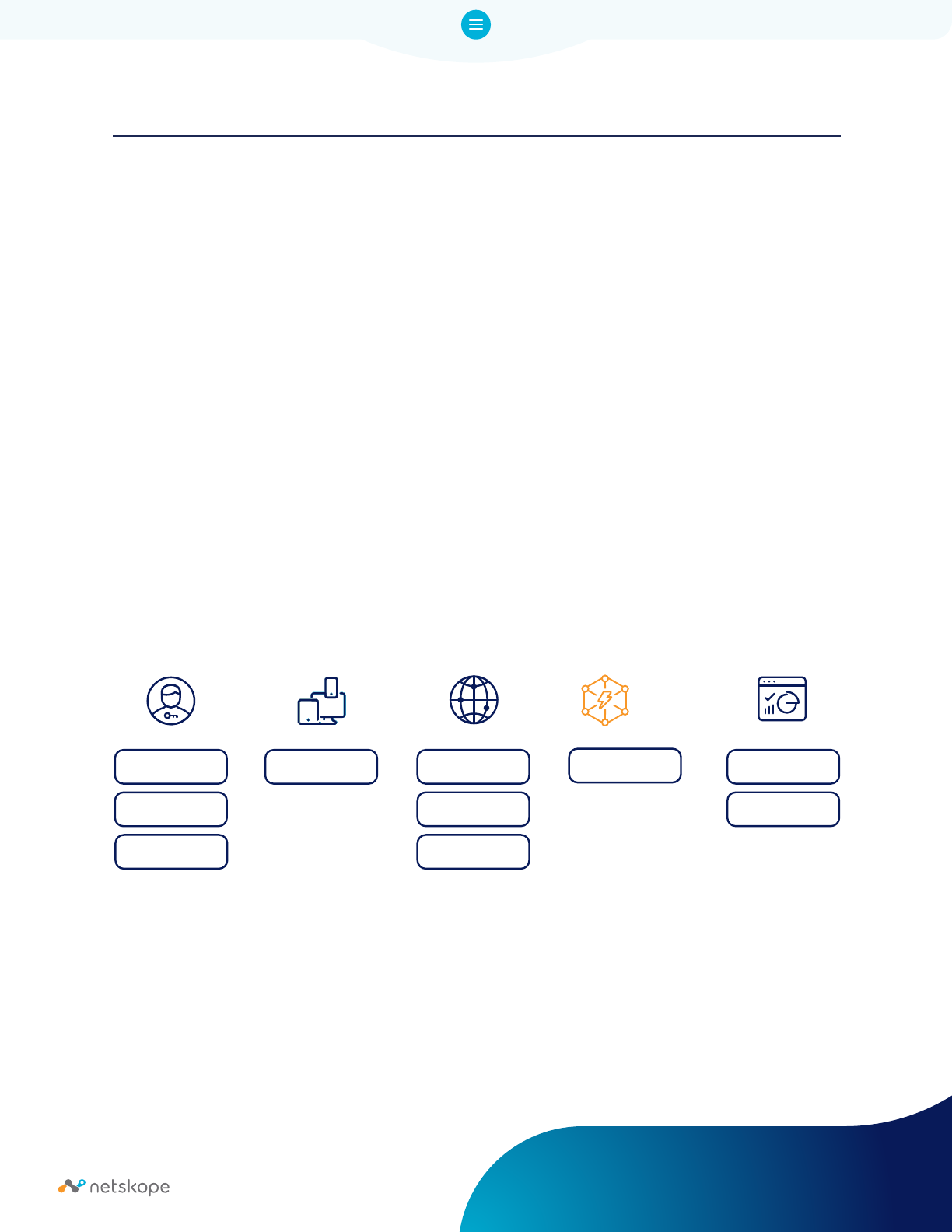
22
TRAFFIC STEERING METHOD WITH NETSKOPE CLIENT
When to use
• Netskope client can be installed on the endpoint.
• Organizations want inline inspection of all trafic - web or non-web from and to the endpoint to be
inspected by the SSE.
• Organizations want a single client for SASE capabilities like Secure Web Gateway, Data Loss
Prevention including endpoint Data Loss Prevention, Threat Protection, In-line Cloud Access
Security Broker, Cloud Firewall, DNS Security, Remote Browser Isolation & SDWAN
Network Performance.
• Organizations want complete visibility into the user and the endpoint.
• Single client with SSE and SDWAN capabilities, especially when the user could be using a patchy
or lossy network connection.
• Need end-to-end visibility to help proactively detect issues with network, endpoint or application
using Netskope Proactive Digital Experience Management (DEM).
This is the Netskope recommended steering method.
As represented in the diagram below, all user trafic to Internet or Internal Private Applications, either
web or non-web, will be steered by the Netskope Client to the closest Netskope NewEdge Data Plane (DP)
or Point-of-Presence (POP).
WHO
Employee
HOW
WHERE
STEERING
SOLUTION
WHAT
Contractor
Server
Internal
Netskope
NewEdge
Client
Internet
All Web
Private Apps
Hybrid
Managed

23
Netskope Client
• The Netskope Client is a lightweight steering agent that provides the most comprehensive control
and visibility.
• The Netskope Client supports a wide variety of operative systems including Microsoft Windows,
Apple macOS, Linux (Ubuntu), Android OS and Apple iOS.
• Netskope Client Agent can be deployed via direct download, email invite, IdP Enrollment, User
Endpoint Management (UEM) or Mobile Device Management (MDM) for remote installation without
user interaction.
• By default, the Netskope Client is installed in “Single-User” mode. This mode should be used for
endpoints that are allocated to an individual user and the device will never be shared. Where
multiple users are sharing the same system or device, the Netskope Client must be installed in
“Multi-User” mode. Examples where multi-user mode should be considered:
◦ Shared Workstations / Laptops.
◦ Persistent and Non-persistent VDI.
◦ Citrix Virtual Apps with Hosted Shared Desktop .
◦ Windows Remote Desktop Services.
◦ Floating/Loaner Laptops when loaner PCs that are given to employees on a temporary basis.
◦ Kiosk Desktops, such as shared desktops in call centers, conference rooms, front desks, etc.
Netskope Client - Connectivity Requirements
Client Tunnel Establishment
The Netskope Client will always attempt to establish a DTLS (UDP/443) or TLS (TCP/443) tunnel directly
with the closest best performing Netskope Data Plane (DP). To allow the Netskope Client to establish a
direct connection with the data plane, the Netskope Client must be able to resolve FQDNs within the
goskope.com zone. Best practice is to allow DNS resolution of any .goskope.com domain names.
Please refer to: https://docs.netskope.com/en/netskope-client-network-coniguration.html for the latest
and updated FQDN and IP list.
The minimum requirement for the Netskope Client to work is to have the internal DNS able
to resolve the domain *.goskope.com. In an environment where internet recursive DNS
is disabled, DNS zone forwarding rules for *.goskope.com must be created. If DNS zone
forwarding is strictly not possible/permitted, then Netskope Client tunnels can’t be used
and an alternate steering method must be used, such as Explicit Proxy over IPSec or GRE
tunnels (EPoT).
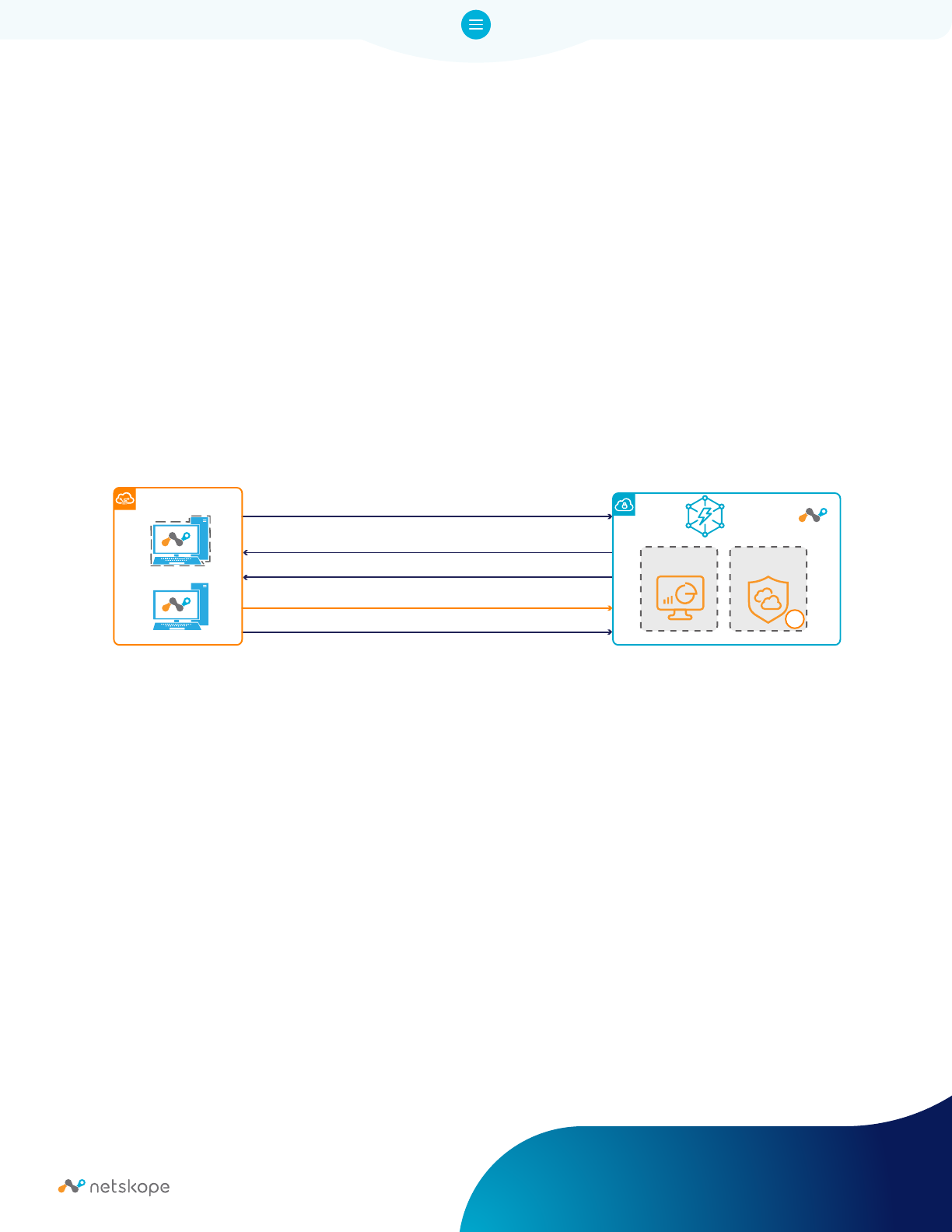
24
Netskope Client - Automatic Data Plane Selection
Netskope utilizes multiple methods to select the optimal Netskope Data Plane to connect users to you will
not have to do any coniguration or assignment for this. The below methods are in order of precedence if
they are enabled on your tenant.
Netskope Global Service Load Balancing
Netskope has added a new service to enhance the Automatic Data Plane section process.
• The client will make a REST API call to gateway.gslb.goskope.com
• The API provides a list of the top 10 Netskope DP based on the client IP geo-location and the
Round-Trip-Time (RTT) for each DP.
• The Netskope Client will then choose a Primary and Backup data plane based on the best RTT.
• The Netskope Client re-evaluates the RTT every 15 minutes and if there is a data plane which
has a 25% better RTT than the currently active one, the Netskope Client will switch to the better
performing data plane.
Figure 1: DP selection using Netskope GSLB API
Managed Endpoints
1. HTTPS API Request to gateway.gslb.goskope.com
NewEdge
Management
Plane (MP)
Data
Plane (DP)
Netskope
Virtual-PC
PC
2. HTTPS API Responds with tenant footprint. DPs are ordered based on "distance"
to the closest DP using GeoIP of the Client
3. Client evaluates the round trip time (RTT) for the top 10 closest DPs
4. Client establishes TLS/DTLS tunnel to the DP with the lowest RTT
5. Client re-evaluates the round trip time (RTT) every 15 minutes.
TLS
Figure 1: DP selection using Netskope GSLB API
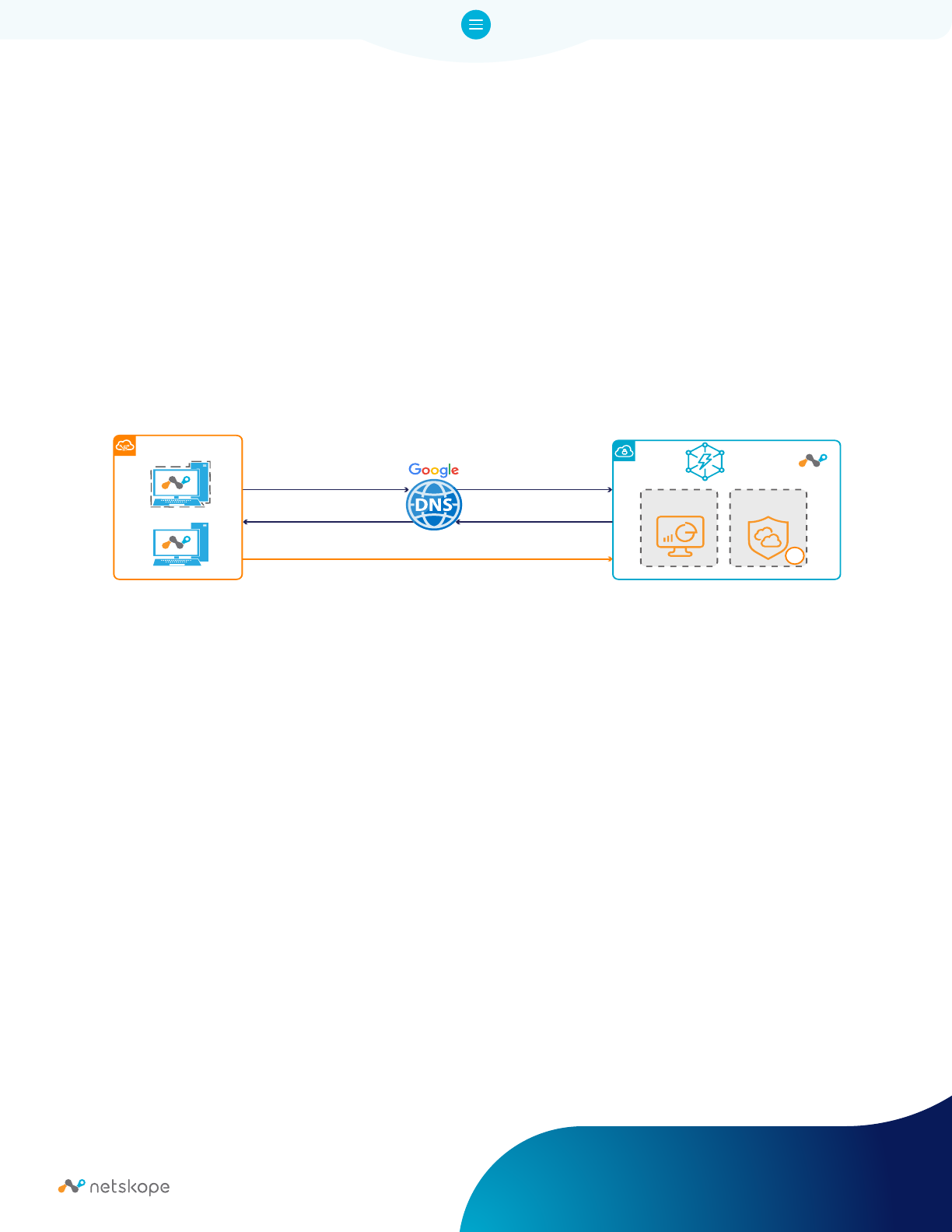
25
Google DNS
If the Data Plane cannot be determined via GSLB API the Netskope Client will fallback to utilizing a call to
Google DNS. In this case:
• The Netskope Client uses Extended Client Subnet (ECS) extension when performing DNS lookups
to determine the closest Netskope data plane. ECS provides the Client IP /24 subnet address in the
DNS request.
• Netskope Client has been designed to use DNS-over-HTTPS (DoH) protocol which supports ECS as
a parameter in the DoH request.
• The Netskope Client is conigured to use Google DNS (dns.google) for all DoH (TCP/443) requests
which are then forwarded to the Netskope authoritative DNS resolvers. Google DNS (dns.google) is
used for the data plane selection only.
• If the Netskope Client can’t communicate with Google DNS (8.8.8.8/8.8.4.4), it will fallback to the
conigured Local DNS (LDNS) obtained by DHCP or conigured on the endpoint.
Figure 2: DP selection using Google DNS
2. DNS request with ECS
3. DNS response
5. Client establishes TLS/DTLS tunnel to the closest DP based on GeoIP
4. DNS over HTTPS response
1. DNS over HTTPS request
gateway-<tenant>.goskope.com
gateway-backup-<tenant>.goskope.com
dns.google
Managed Endpoints
NewEdge
Management
Plane (MP)
Data
Plane (DP)
Netskope
Virtual-PC
PC
TLS
Figure 2: DP selection using Google DNS
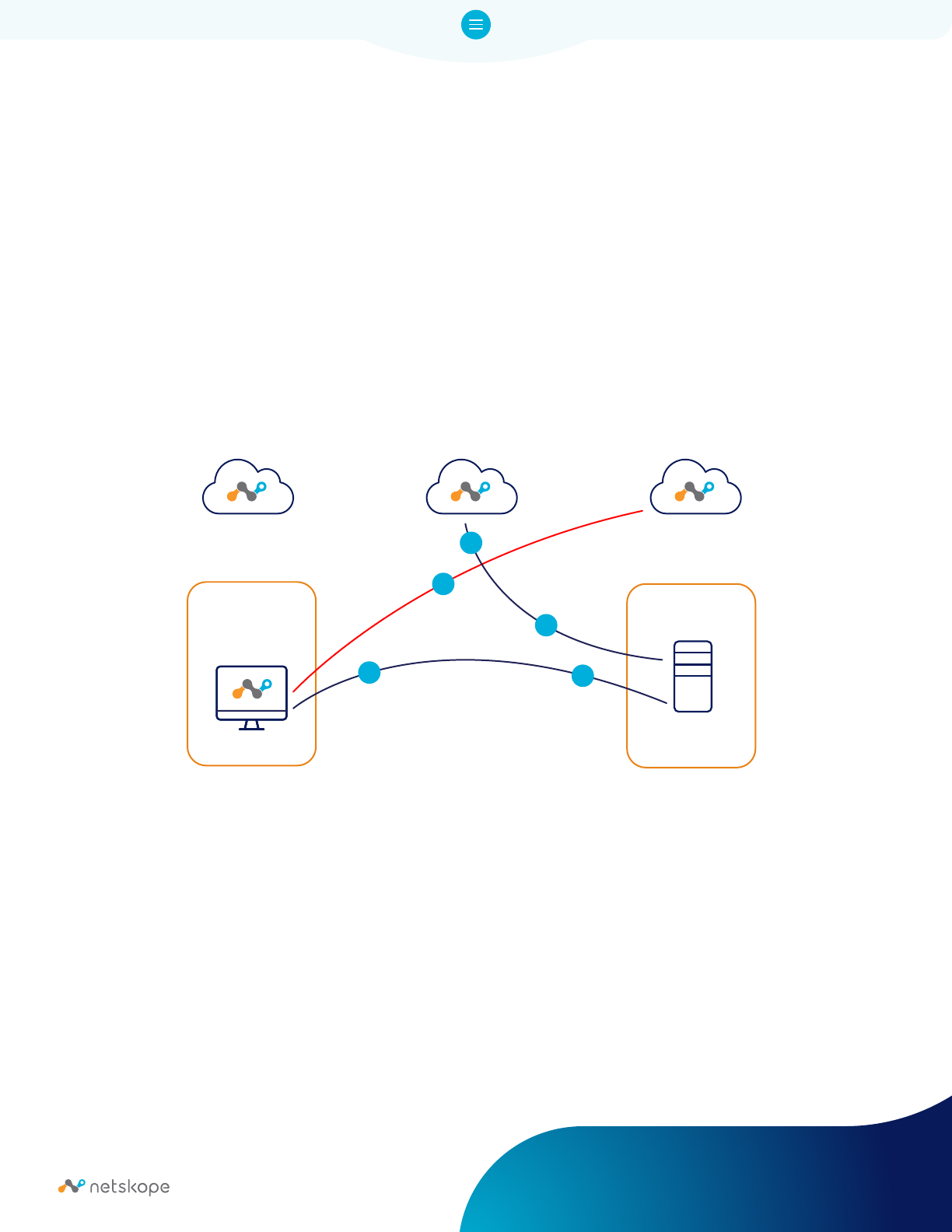
26
Local DNS
The inal DNS method is Local DNS (LDNS). In this case the Netskope Client will use the corporate DNS
infrastructure to resolve the best Netskope Data Plane.
However, with this method there is a riks, that the user does not get connected to the closest and best
Data Plane or Point of Presence (PoP) when the corporate DNS infrastructure is too centralized.
Wrong Nestkope PoP selection with corporate DNS:
1. Client request DNS resolution for gateway-x.goskope.com
2. HQ corporate DNS server is asking Netskope DNS server with the HQ internet breakout address.
3. Netskope DNS responds with a German PoP address.
4. Netskope Client is connecting to the German PoP and to Spain.
Figure 3: Wrong PoP selection with corporate DNS
Note: Netskope recommends blocking DNS over HTTPS (DoH) via Netskope Real-Time Policy as it forces
the browsers to use regular DNS hostname resolution. In this way, Netskope Client continues to monitor
the DNS responses and maintain the IP address to hostname mapping, and honor any steering exceptions
as needed.
Netskope
POP Spain
Netskope
DNS
Netskope POP
Germany
HQ Germany
Corporate
DNS Service
Branch Oice
Spain with local
Internet breakout
4
3
1
2
3
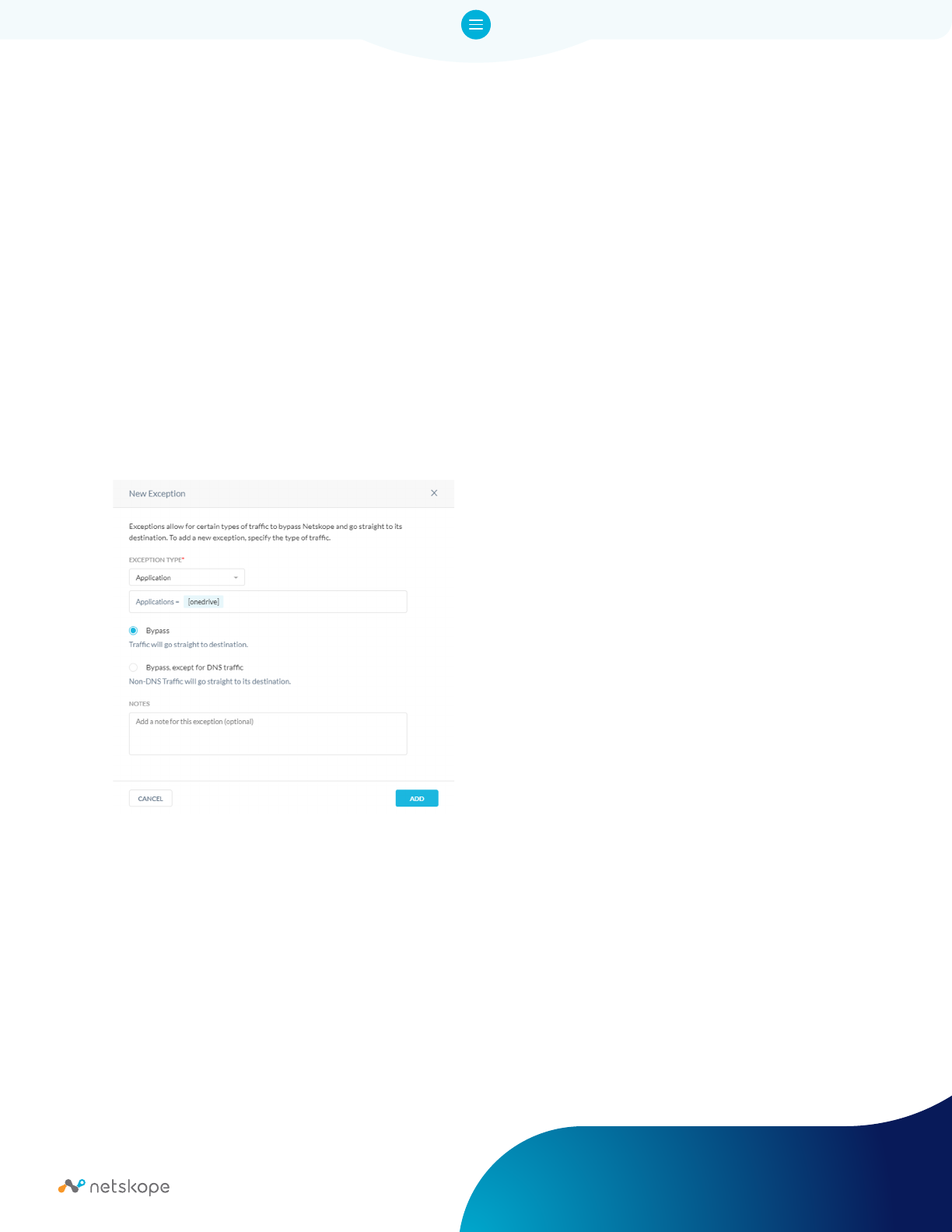
27
Netskope Client - Steering Conigurations
By default the Netskope Client will intercept HTTP/HTTPS (TCP 80 & 443) trafic when enabled for Web/
Cloud Apps OR all TCP, UDP and ICMP when the Cloud Firewall module is enabled. Custom ports can be
conigured to be treated as HTTP/HTTPS trafic and be evaluated against the SWG rules. Trafic is steered
to Netskope SSE based on the Steering Coniguration.
Steering Exceptions
Steering Exceptions can be conigured for the following types of elements:
• Certiicate Pinned Applications
• Web Categories
• Domains
• Source/Destination Locations
• Source Countries
When trafic matches a Steering Exception, the Netskope Client will not tunnel the trafic to Netskope
SSE and it will be handled by the underlying operating system for processing and routing.
For example, in the picture above, for the speciic application of onedrive (Netskope will automatically
get the domains) we are setting up a Bypass, this means that the trafic will go straight to its destination,
not steered through Netskope.
However, Certiicate Pinned Applications have the option to Bypass Netskope Proxy + Tunnel, which will
tunnel the trafic to Netskope and egress via Netskope Data Plane, but it will bypass SSL decryption and
policy enforcement. This provides additional visibility and it’s recommended to enable Bypass + Tunnel
for Certiicate Pinned Applications as it prevents the need to open and manage irewall rules for
these applications.
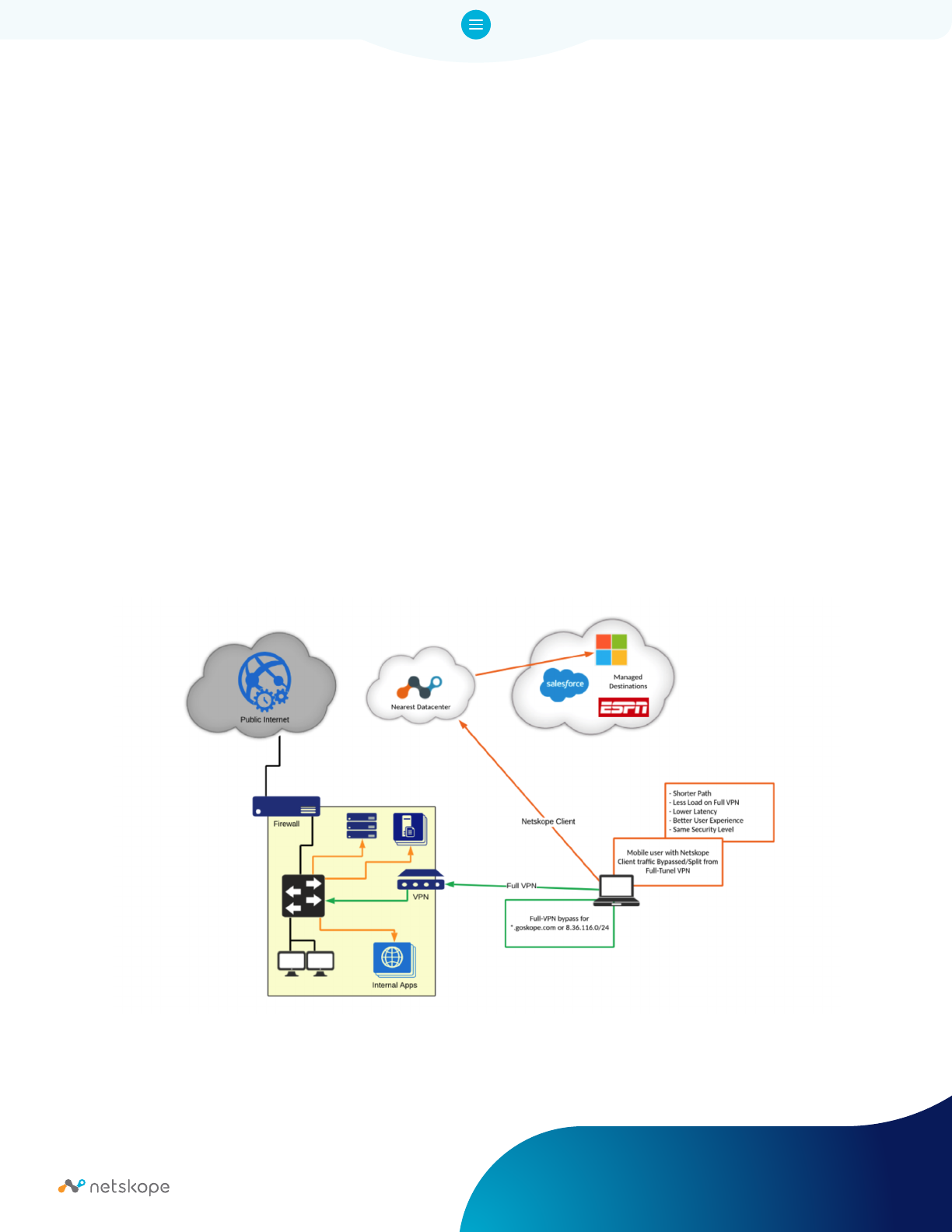
28
Netskope Client - Interoperability with 3rd party VPN clients
When working remotely, many customers conigure their VPN clients in “Full” tunnel mode to steer all
network trafic from the endpoint to the data center. This is typically done as a security best practice to
ensure no trafic from the managed endpoint can evade inspection of the enterprise network security
controls. When the Netskope Client is deployed, it establishes a TLS and DTLS tunnel to the Netskope
Security Service Edge (SSE), and steers web/cloud trafic to the Netskope SSE applying security functions
such as DLP, threat protection, access control, etc.
If the VPN tunnel is established in full tunnel mode, the Netskope Client (TLS and DTLS) tunnels will be
routed over the VPN tunnel. This presents the following suboptimal outcomes:
• Trafic to the Netskope SSE will take a suboptimal route, especially in a distributed environment
where remote users are geographically distant from the enterprise network. Such routing defeats
many beneits of Netskope's distributed SSE network.
• Internal security infrastructure is blind to the Netskope bound trafic, due to the requirement to
disable SSL Decryption - it has no visibility into TLS/ DTLS tunnels and thus provides no additional
security value.
• Customers don’t realize the full beneit of leveraging SSE for ofloading security processing from
their on-premises infrastructure, such as SSL/TLS decryption.
For the Netskope Client to interoperate with 3rd party VPN clients, the VPN client should be conigured
in Split tunnel mode to allow Netskope tunnel to egress directly via Internet to the closest Netskope data
plane location.
Figure 4: Tunnel with Exception VPN (Recommended)
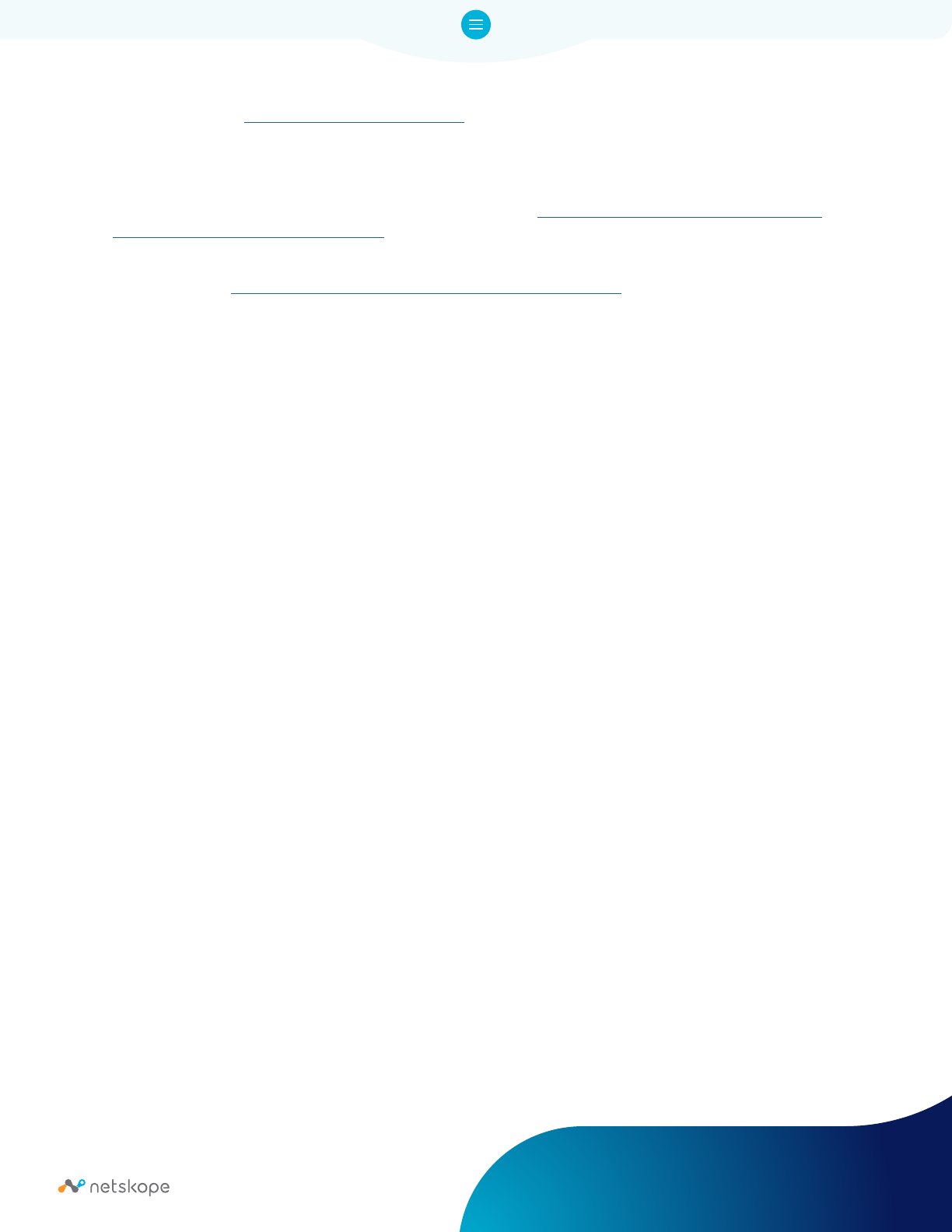
29
Additional reading Don’t Strangle your SASE article
In addition to coniguring Split tunnel mode, you will need to add Steering Exceptions for the Netskope
Client to bypass the VPN concentrator gateway IP addresses to prevent SSL VPN trafic being steered
to Netskope SSE. Steering exceptions need to be conigured in the Netskope Tenant User Interface (UI).
Please refer to Exception Coniguration for VPN Applications: https://docs.netskope.com/en/exception-
coniguration-for-vpn-applications.html
For more recommendations and pros/cons of Split vs Full VPN tunnels refer to this blog post from the
Netskope portal: https://www.netskope.com/blog/dont-strangle-your-sase
Beneit of deploying Netskope Client
• Netskope Client is the preferred steering method and customers are always advised to deploy
whenever possible. It facilitates universal connectivity to the Netskope Security Cloud regardless
of the user and endpoint location.
• These beneits are a solution for common issues of the past such as lack of security if the user is
outside of the organization, lack of Zero Trust approach to the access to company resources and
no integration with the identity and the security stack. This causes companies to have a highly
complex operation with a lot of blind spots that put the organization at risk.
• In the context of discussing how Netskope addresses challenges with legacy architecture, the
following sections highlight the beneits for organizations looking to enhance their network
security, user experience, and operational eficiency:
◦ Remote worker support
▪ Network based architecture usually relies on backhauling the trafic to a datacenter to apply
network based security. This generates higher latency and capacity issues.
▪ Netskope Client can redirect dynamically to the closest datacenter and leverage New Edge
peering to provide the best user experience.
◦ Authentication
▪ Authentication has always been a challenge with proxies, which rely on HTTP authentication
mechanisms to authenticate/identify the user. But it is not transparent for the browser or the
application that needs to support it and generates a dependency on the directory/IDP. As a
consequence it can generate performance and availability issues while not accurate (IP based
authentication is weak). Moreover, customers need to manage complex exception lists for
applications like ofice applications which don't support HTTP authentications.
▪ Netskope Client solves those issues by performing client certiicate based authentication
at the network level (SSL session to connect to the Data Plane), which means:
• It’s only done once, not for each domain/session.
• It’s invisible for the browser or the app, it cannot fail, therefore no exception to manage.
• It’s not based on the IP but on the SSL session, therefore more secure, no problem to share
the same IP.
• It doesn’t need any interactive validation with any IDP, so even if the IDP or AD is down the
authentication is still working.

30
• Easier to deploy
◦ Network based deployment requires architecture design, build, validation which takes months to
complete and requires additional work on the authentication integration, PAC hosting and Root
CA deployment.
◦ Netskope Client can be easily deployed with SCCM (System Center Coniguration Manager) or
any EDM (Enterprise Device Management), the authentication and SSL CA are automatically and
transparently deployed.
• Flexible steering
◦ Network based steering relies mainly on PAC iles which are complex to manage. Don’t forget
that if the PAC distribution is not properly working, the internet access will be broken. Internet
outages - because of PAC mistakes - are common. Dynamic proxy distributions are often very
complex to set and operate. The other issue with PAC iles is that it doesn’t guarantee that the
low will go through the proxy. An application may not support the PAC ile or a malware can just
ignore it.
◦ Netskope client allows to conigure steering centrally and provide smarter decisions like dynamic
steering or SNI based steering. It’s even possible to provide fail close mechanisms. Finally, there
is no risk of syntax errors or PAC availability with Netskope Client steering.
◦ In environments without a default route to the Internet, and or no public DNS resolution,
Netskope Client can be deployed in Explicit Proxy mode.
• Better Security
◦ When PAC ile are used, applications can ignore or bypass explicit proxy.
◦ Netskope Client cannot be disabled (unless admin allows it) and can leverage additional security
features like fail close and device classiication.
◦ The root certiicate for SSL inspection are automatically installed with the Netskope Client.
• Enhanced user experience
◦ With network based deployment, it is impossible to display user notiication / error messages
inside native apps. It is also challenging to insert interactive messages inside complex SaaS
services like O365 or G Suite. Therefore users won't be aware of what's wrong in the application,
resulting in a bad user experience.
◦ With Netskope Client, we can leverage popups to display notiications when we cannot display
them in the browser: for native apps, for complex SaaS applications in the browser. Moreover, we
can leverage the notiication to request end user feedback (justiication) which legacy solutions
cannot provide. In these cases, the users are aware of what’s wrong with the application,
resulting in a better user experience.
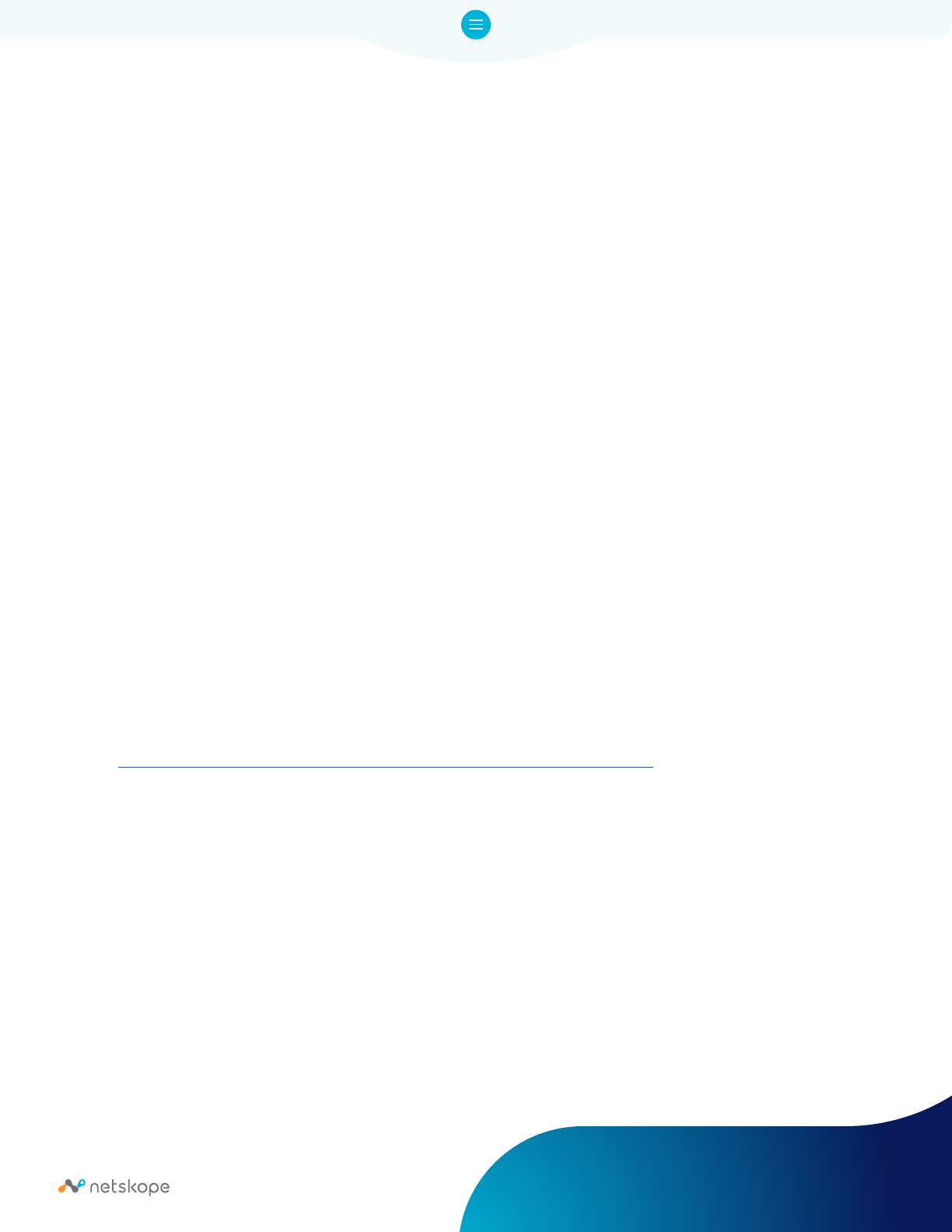
31
• Simple management
◦ Troubleshooting network based deployment is often complex because the user activity is mixed
with all users and on the device there are no embedded troubleshooting tools. Packet capture is
often the only way to troubleshoot but requires additional software and rights to be performed.
◦ Netskope Client is extremely simple to troubleshoot.
◦ The debug log is providing details about steering decisions, coniguration updates, behavior of
the client in general.
◦ Debug log level can be controlled remotely.
◦ Logs can be retrieved centrally, without any user action.
◦ Packet capture and speed test can be performed directly from the client.
◦ Netskope Client also provide remote control (enable/disable/fail close) and granular upgrade
control (latest version, speciic golden release).
• Operational Cost Reduction
◦ No on-premises proxy software/hardware, decryption hardware, management tools and load
balancers required.
◦ Zero Trust: User Identity and Endpoint Identity is available for granular policy-based decisions.
◦ Zero Trust: Device Classiication / Device Posture.
◦ Operation simpliied: Uniied SWG, CASB, CFW, ZTNA and Endpoint DLP using a single client.
◦ Although compatible, No on-premises proxy software/hardware, decryption hardware,
management tools and load balancers required for this deployment.
◦ Always ON.
More information about the Netskope Client can be reviewed on the Netskope Documentation site
(https://docs.netskope.com/en/netskope-help/trafic-steering/netskope-client/).
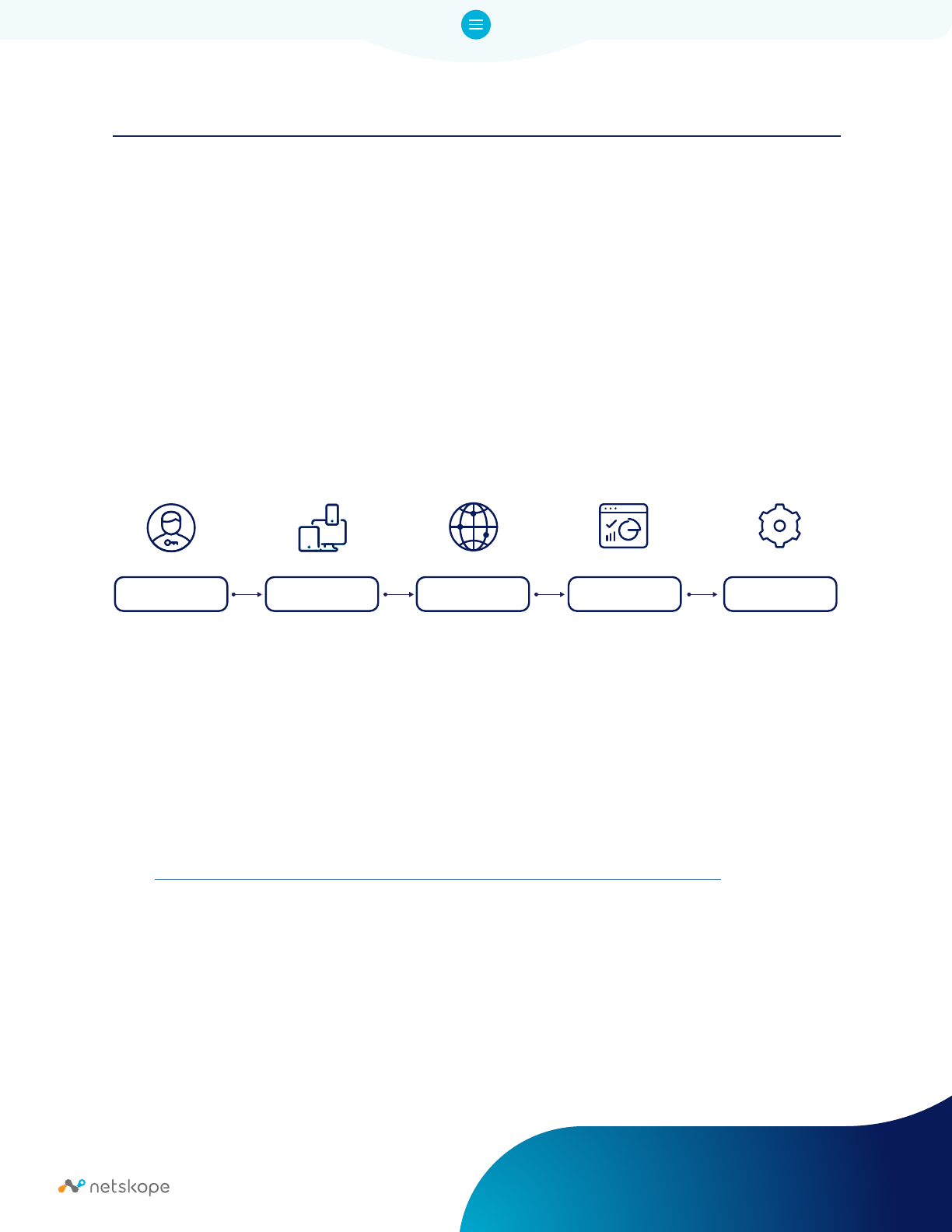
32
TRAFFIC STEERING METHOD WITH NETWORK TUNNELS
When to use
• When it is not possible to install Netskope client on the endpoint. In this scenario, it is
recommended to steer the trafic from the endpoint to Netskope NewEdge DP over a
network tunnel.
• Netskope supports IPSec or GRE tunnels from a capable device, such as a router, irewall,
SDWAN appliance, or public cloud platform such as AWS, Azure and GCP.
• Scenarios where network tunnels should be used/considered:
◦ Server that run without an explicit user login.
◦ Unmanaged devices on a managed network, for example, Guest Wii.
◦ Devices that don’t support Netskope Client, for example, IoT/Smart devices.
Trafic can be steered from the endpoints over the Network Tunnels to Netskope NewEdge DP using
either:
• Transparent Policy Based Forwarding/Routing (PBF/PBR) or
• Coniguring an Explicit Proxy, better known as Explicit Proxy over Tunnel (EPoT).
• Netskope Borderless SDWAN offering can also be considered, which provides orchestration for
tunnels and can automatically set up tunnels to Netskope NewEdge DP from its HW-based or virtual
edge devices. This provides a seamless way to steer trafic to Netskope using network tunnels.
• Integrations with other SDWAN vendors are also available and are documented here
https://docs.netskope.com/en/netskope-help/integrations-439794/ipsec-and-gre/.
STEERING
SOLUTION
WHO
ANY
HOW
WHERE
WHAT
Internal Internet
IPSEC/GRE
ANY
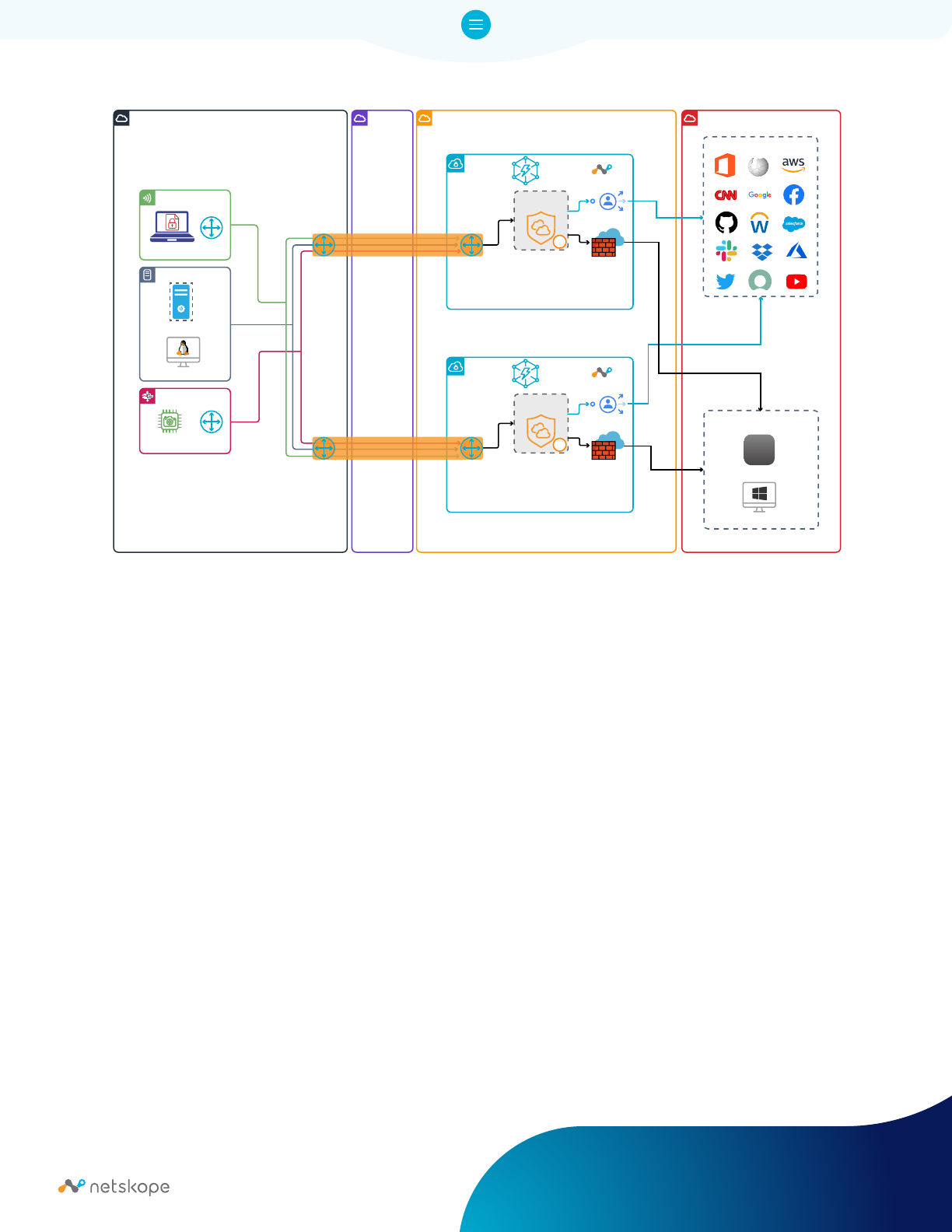
33
Figure 5: Tunnel Steering Example
Prerequisites
• Install the Netskope Root and Intermediate CA certiicate on all devices where SSL decryption
is required.
• SAML IdP to authenticate users.
• Ensure that Many-to-One NAT is not enabled on the network device that is initiating a tunnel to
Netskope so that the real endpoint device IP is used for identity and policy-based decisions.
• For resiliency, create at least two tunnels to different Netskope NewEdge DPs from each site.
IPSec Tunnels
Internet Protocol Security (IPSec) is a secure network protocol that authenticates and encrypts the
packets of data to provide secure encrypted communication between two endpoints.
Supported features and limitations:
• Maximum of 16,000 hosts per IPSec tunnel.
• The maximum number of tunnels (SAs) per IKE connection at one time is 10.
• 500 Mbps throughput limit per tunnel. 1Gbps is available with Netskope approval and is an add-on
SKU available for purchase.
• NATT traversal must be enabled.
Customer Transit Netskope Private Cloud for SSE Internet
IPSec / GRE
IPSec / GRE
HTTP / HTTPS/
TCP / UDP
HTTP / HTTPS/
TCP / UDP
Cloud / Web Apps
Non-Web Apps
Explicit Proxy
loT Trasparent
Trasparent
Laptop
Virtual Server
Unmanaged / Guest
Servers
Non-Proxy Aware
VM Linux
Data
Plane (DP)
TLS
NewEdge
Netskope
Data Plane 1 (Primary)
Tunnel
Gateway
Cloud
Firewall
Next Gen
SWG
Data
Plane (DP)
TLS
NewEdge
Netskope
Data Plane 2 (Backup)
Tunnel
Gateway
Cloud
Firewall
Next Gen
SWG
>
_
SSH
Figure 4: Tunnel steering example

34
Supported IKEv2 Parameters
• Phase 1 Parameters
◦ Encryption algorithms: AES128CBC, AES192CBC, AES256CBC
◦ Integrity algorithms: SHA256, SHA384, SHA512
◦ DH Group: 14, 15, 16, 18
◦ SA lifetime: 24 hours
◦ Dead Peer Detection (DPD)
• Phase 2 Parameters
◦ Encryption algorithms: AES128CBC, AES256CBC, AES128GCM, AES192GCM,
AES256GCM, Null
◦ Integrity algorithms: SHA256, SHA384, SHA512
◦ DH Group: 14, 15, 16, 18
◦ PFS: Supported
◦ SA lifetime: 2 hours
GRE Tunnels
Generic Routing Encapsulation (GRE) is a tunneling protocol that can encapsulate a wide variety of
network layer protocols inside virtual point-to-point links. GRE uses logical tunnel interfaces that
terminate to a Netskope NewEdge DP. The NewEdge GRE gateway validates the source peer (router/
irewall) IP of the tunnel against the conigured source peer in the Netskope User Interface (UI).
Supported features and limitations:
• Maximum of 64,000 hosts per GRE tunnel.
• 1 Gbps throughput limit per tunnel.
• Maximum of one (1) tunnel per source peer IP for each Netskope data plane.
• ICMP keep-alive must be sent to the probe IP only.
Despite the fact that the GRE tunnel is not encrypted, web trafic traversing the GRE tunnel is encrypted
using HTTPS for the vast majority of trafic. The small remaining percentage of trafic sent with HTTP
which is not encrypted and usually accounts for less than 5% of trafic, will be sent in the clear.
• IKEv2 only.
• Multiple tunnels can be created per source peer IP, using different source identities.
• Authentication: Pre-Shared Key.
• Trafic from the same user or endpoint must go through the same tunnel. Load balancing is
supported using Source IP persistence.

35
Policy Based Forwarding/Routing
Policy Based Forwarding/Routing (PBF or PBR) is transparent to the endpoint and should be conigured
to steer TCP/80 (HTTP) and TCP/443 (HTTPS) by default. Non-standard web ports are also supported but
must be conigured in the tenant steering coniguration for the trafic to be accepted. If Cloud Firewall
has been enabled, you can steer all Internet bound TCP, UDP and ICMP trafic over the tunnel.
PBF has the advantage of not requiring any speciic coniguration on the end point to steer trafic to
Netskope, therefore can support applications that are not “proxy aware”. PBF supports Authentication
using SAML or can be disabled based on Domain, Web Categories, User Source IP Address and Egress
(ISP) Source IP Address.
Important: Only steer trafic that is conigured to be accepted over the network tunnel. All other trafic will
be dropped.
Figure 6: IPSec / GRE – Policy Based Forwarding
NewEdge
Management
Plane (MP)
Data
Plane (DP)
SSL
IDP/IAM
GRE / IPSec
DNS
Destination
1
4
2
3
5
6
7
Flows
GRE/IPSec tunnel already established
1: DNS Resolution
Go to step 6 if authentication is not needed
(exception or valid surrogate)
2: HTTP(S) request to web server, redirect
to nsauth virtual url, PBR conigured
to route via tunnel
3: nsauth redirect to IDP
4: Authentication to IDP via SAML
5: nsauth receive SAML assertion, add
surrogate and redirect to URL
6: HTTP(S) request after authentication
7: Netskope Proxy to destination
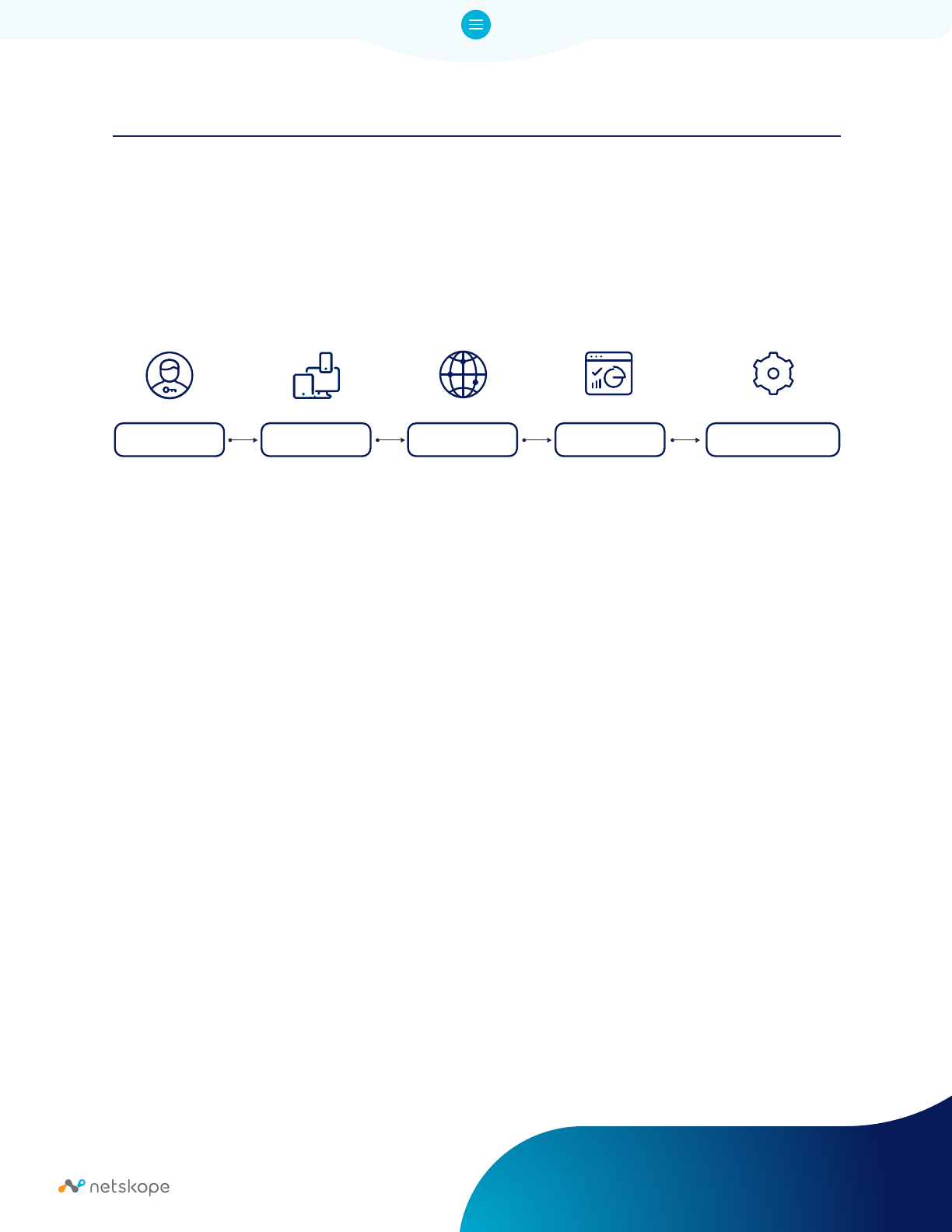
36
TRAFFIC STEERING METHOD WITH EXPLICIT PROXY OVER TUNNEL EPOT
When to use
• When it is not possible to install Netskope client on the endpoint, but it is possible to conigure an
Explicit Proxy on the endpoint.
• When tunnels can be setup from the site to Netskope NewEdge DP, but it is not possible to deine
Policy Based Forwarding to steer trafic from the endpoint to the tunnel.
EPoT is like any other explicit proxy coniguration, but the explicit proxy endpoint is only available when
an IPSec or GRE tunnel is established. You can steer clients to use the explicit proxy by using a Proxy
Auto-Coniguration (PAC) ile or setting the explicit proxy IP and port manually within the client.
Note: The dedicated Explicit Proxy IP is 163.116.128.80/163.116.128.81, port 80. This IP address
is accessible from any Netskope DP and terminates locally.
Prerequisites
• IPSec/GRE Tunnels from the site to Netskope NewEdge DP.
• Explicit Proxy to be deined using a Proxy Auto-Coniguration (PAC) ile or setting the Explicit Proxy
IP and Port manually on the endpoint.
• SAML IdP to authenticate users.
• Add a /32 route for the dedicated Explicit Proxy IP addresses 163.116.128.80/163.116.128.81,
port 80 to be routed over the network tunnel.
STEERING
SOLUTION
WHO
ANY
HOW
WHERE
WHAT
Internal Internet - Web EPOT (IPSEC/GRE)ANY
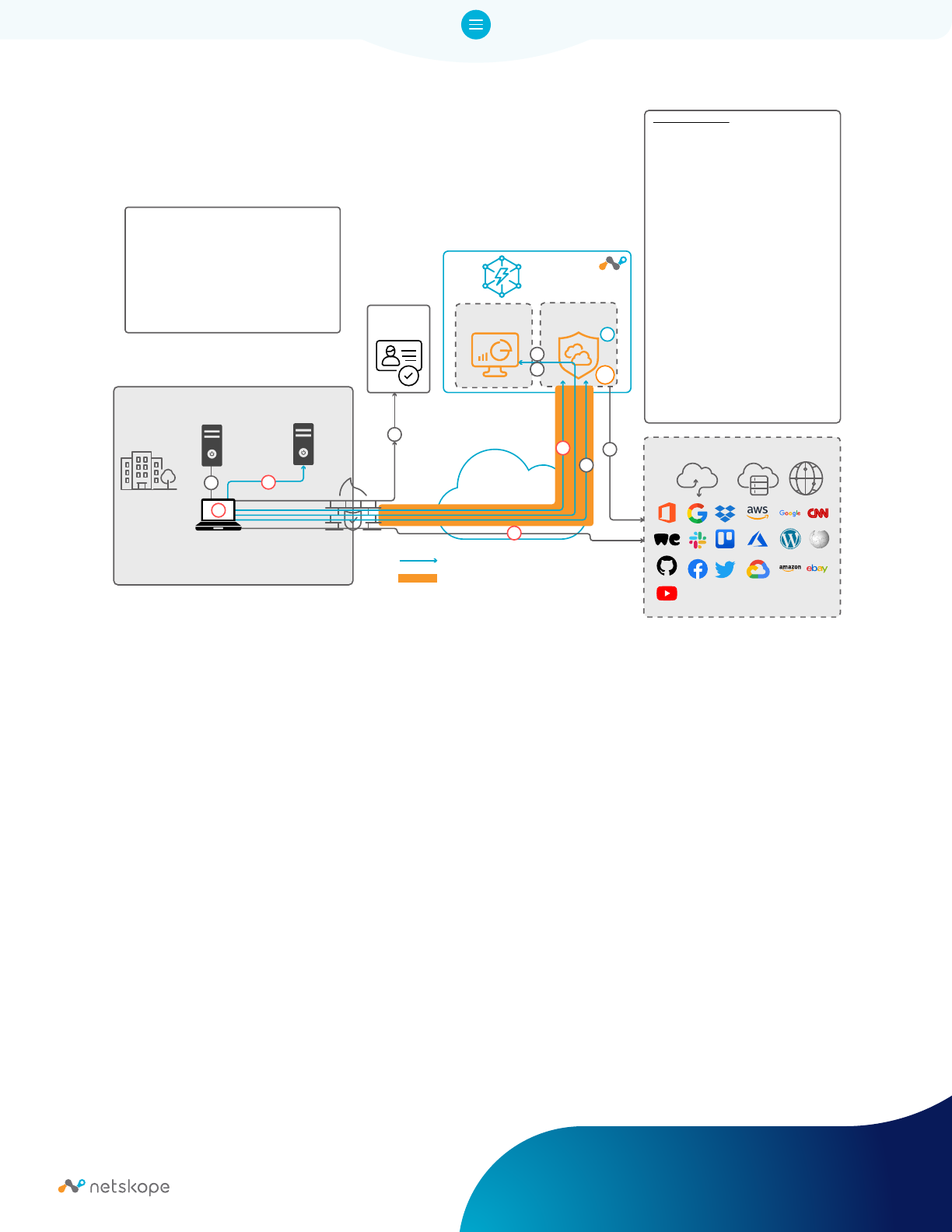
37
Figure 7: IPSec / GRE – Explicit Proxy over Tunnel
NewEdge
Management
Plane (MP)
Data
Plane (DP)
SSL
IDP/IAM
IPSec / GRE
Explicit Proxy over Tunnel (EPoT)
Proxy
Auto-Configuration
(PAC)
Destination
On-Premises
Proxy
1
3a
3c
3b
3
5a
Explicit Proxy Connection
GRE / IPSec Tunnel
2c
4
5b
2a
2b
Connection Flows
IPSec / GRE tunnel established.
1: PAC ile download. URL (web or cloud
app, e.g. outlook.com) compared to the PAC
steering rules.
2: If the HTTP/S request matches the
Netskope steering rules, it is forwarded to
the DP explicit proxy over the tunnel (2a).
If it doesn't, it will follow the conigured
routing (2b) or sent to another explicit
proxy (2c).
3: If the user has not been authenticated or
the authentication refresh interval has
expired, redirect to the SAML
Forward Proxy (FP).
3a: SAML FP will redirect the browser to the
SAML IDP with an AuthnRequest. User will
authenticate.
3b: SAML FP receives SAML Assertion, add
IP or Cookie surrogate.
3c: Redirect browser to original URL.
4: SSL Decryption, Real-time Protection
(DLP, Threat, Web Filtering) is applied.
5a: Clean traic is allowed OR
5b: Block or Coach messages are displayed,
and traic is denied or redirected
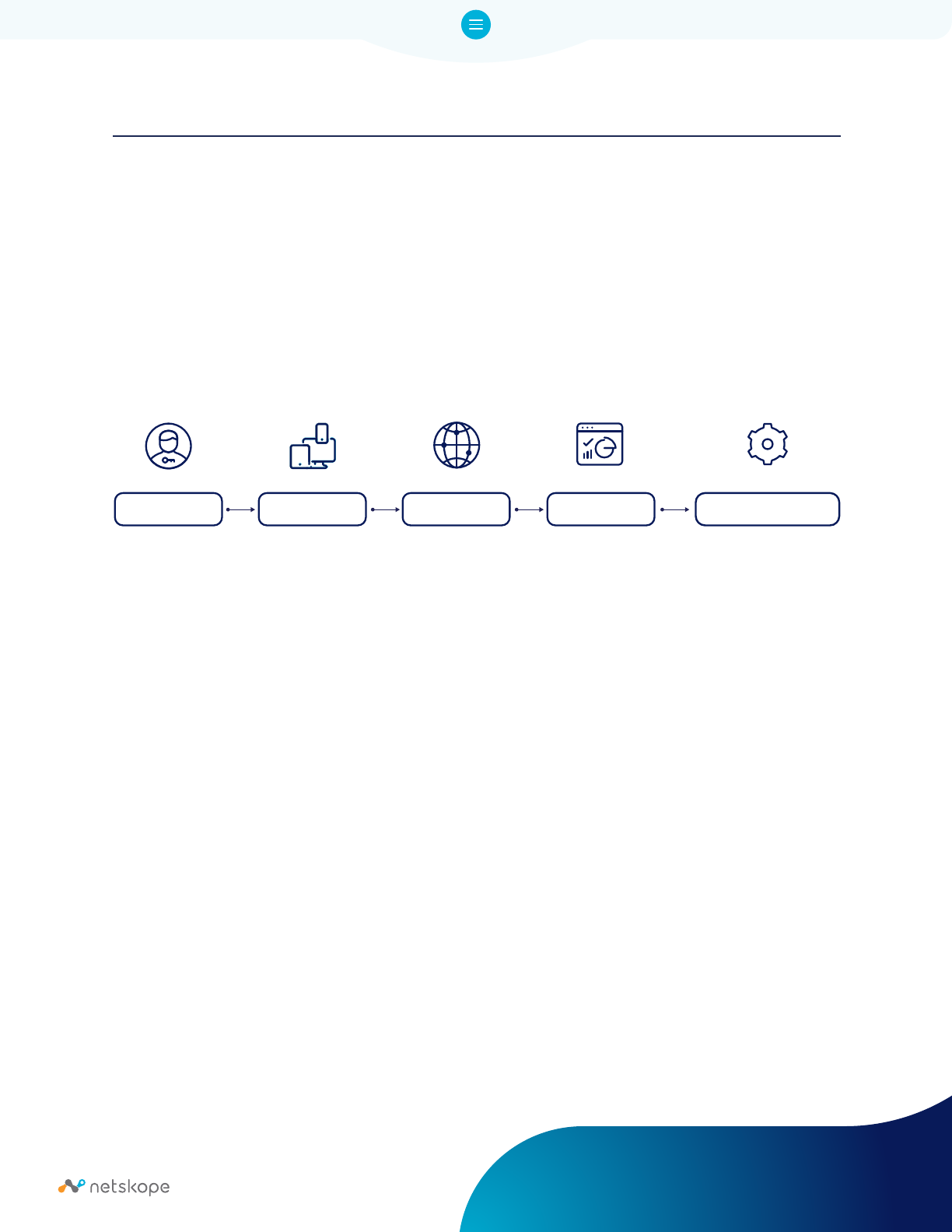
38
TRAFFIC STEERING METHOD WITH CLOUD EXPLICIT PROXY
When to use
Another way to steer trafic inline to Netskope SSE is via Cloud Explicit Proxy (CEP). This method can
be leveraged when a Netskope Client cannot be installed or if there is a preference for Explicit Proxy
architecture, for example when the network is a highly secure environment that doesn’t have a default
gateway. Additionally, Cloud Explicit Proxy does not require an IPSEC or GRE tunnel and can be reached
from the Internet.
Please note that this Cloud Explicit Proxy only supports browser-originated trafic, and is not supported
with desktop or mobile thick/native apps.
Prerequisites
1. The Operational System or Browser explicit proxy settings should be changed to use a PAC ile or
point directly to the Netskope explicit proxy FQDN.
2. The Certiicate Authority for SSL decryption should be manually installed.
a. For roaming users leveraging this architecture, an additional CA has to be installed for the
Captive Portal (CN: eproxy.caadmin.netskope.com).
2. The local network irewall should allow connections to port 8081 on the designated explicit proxy
FQDN, for example eproxy-<tenant_name>.goskope.com
3. Users can be identiied by your identity provider (IdP) with Single-Sign on or the source IP’s can be
added to the Allowlist and bypassed from authentication.
4. When using your IdP for Single-Sign On the IdP portal domain(s) should be bypassed from
authentication to guarantee that the page successfully loads.
STEERING
SOLUTION
WHO
ANY
HOW
WHERE
WHAT
Internet Internet - Web
Cloud Explicit Proxy
ANY
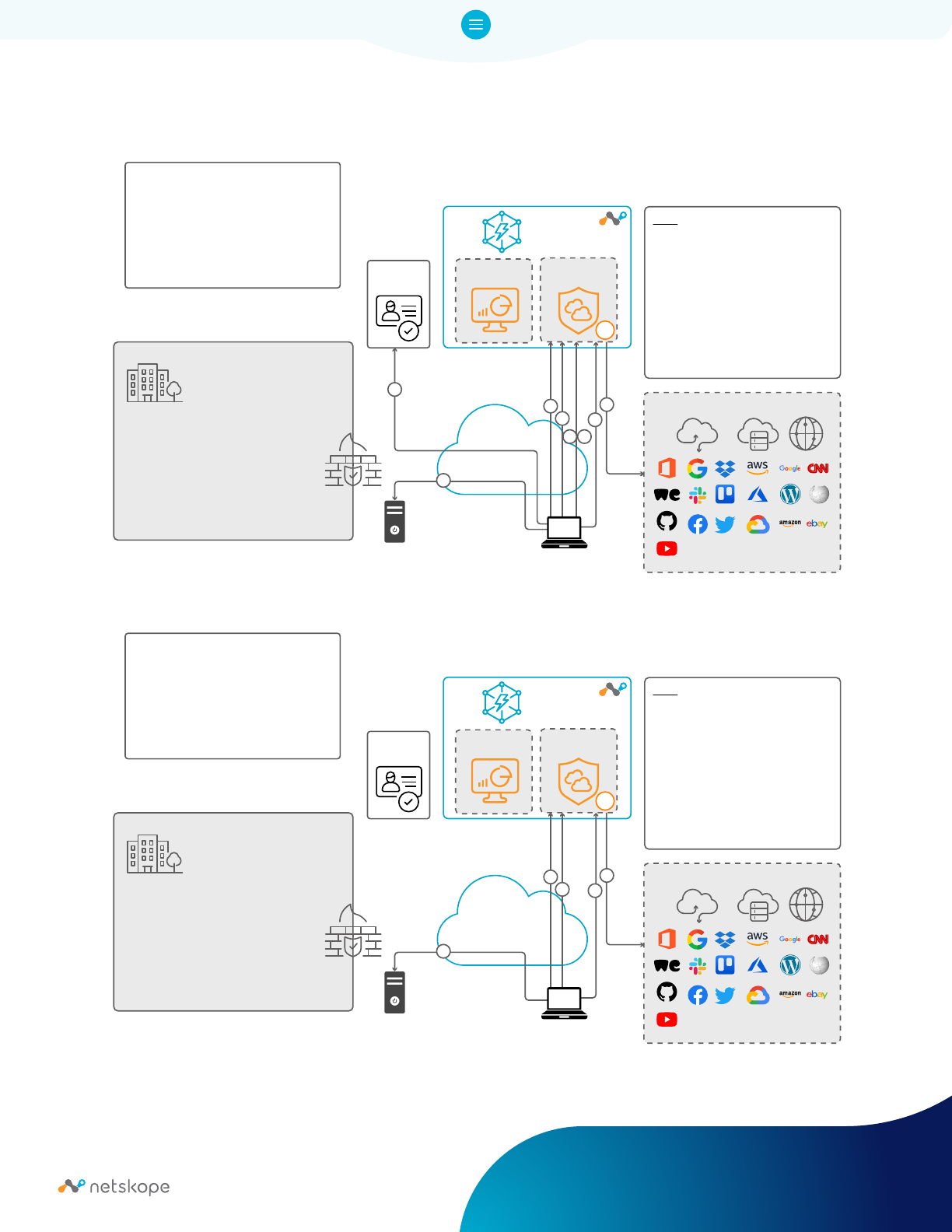
39
The architectures below demonstrates how CEP works on the Netskope SSE Platform when a user is
roaming:
Figure 8: CEP - First Access (before authentication)
NewEdge
Management
Plane (MP)
Data
Plane (DP)
SSL
IDP/IAM
Cloud Explicit Proxy
(CEP)
after initial authentication
Destination
PAC
Flows
1: PAC download
If authencation cookie is set for the domain,
go to step 4
2: HTTP(S) request to NS Proxy, redirect to
authservice virtual url
3: device is connecting to authservice with
valid authentication cookie, user is
identiied and redirected to initial request
4: HTTP(S) request with authentication data
5: Netskope Proxy to destination
1
2
3
4
5
NewEdge
Management
Plane (MP)
Data
Plane (DP)
SSL
IDP/IAM
Destination
PAC
Flows
1: PAC download
2: HTTP(S) request to NS Proxy, redirect to
authservice virtual url
3: user select the tenant on authservice to
enter tenant name.
4: form sent to nsauth, which send redirect
to customer IDP
5: Authentication to IDP via SAML 6: nsauth
receive SAML assertion, add surrogate and
redirect to URL
7: HTTP(S) request after authentication 8:
Netskope Proxy to destination
1
5
2
3
4 6
7
8
Cloud Explicit Proxy
(CEP)
First access
Figure 9: CEP after initial authentication
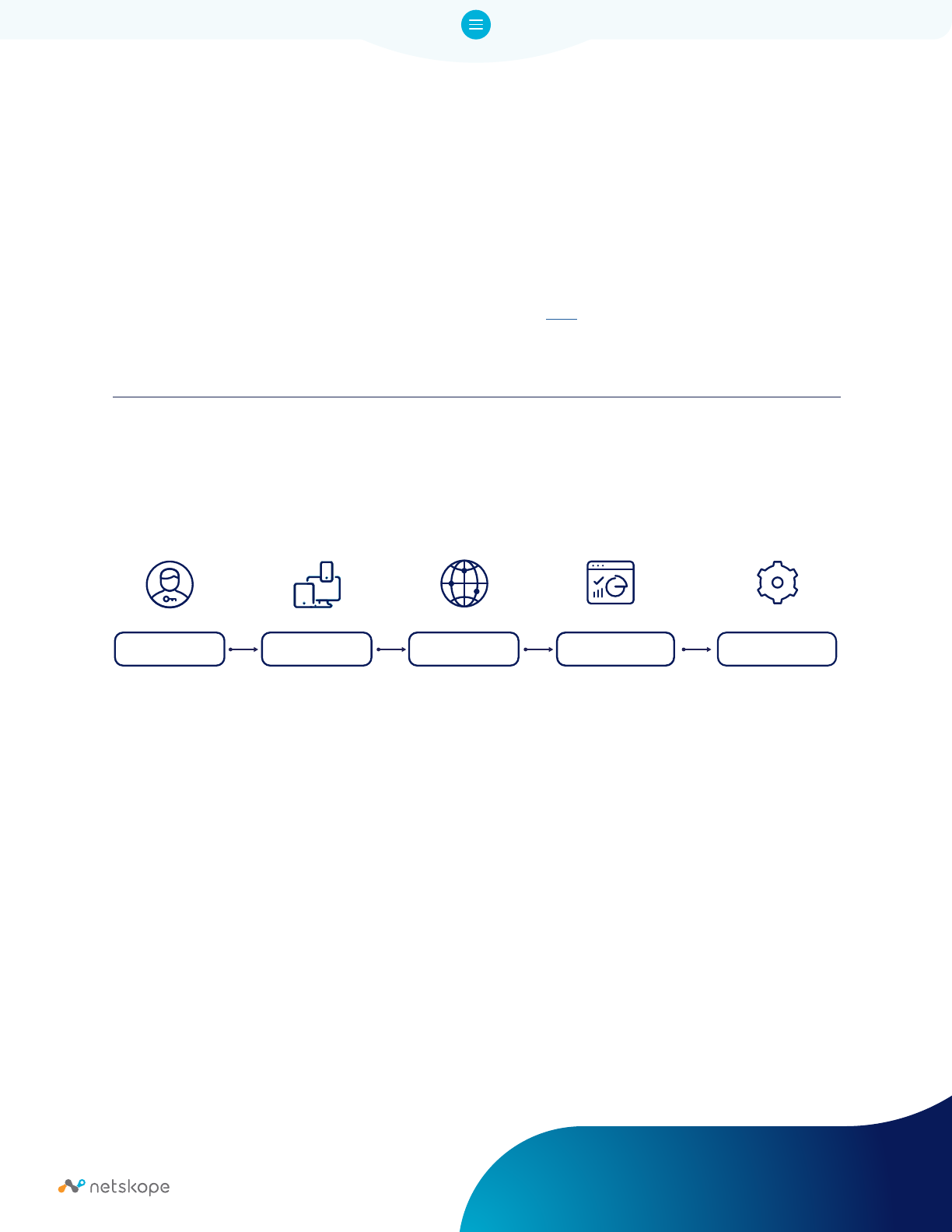
40
Support for ChromeOS devices
For enterprises that use managed Chromebooks and want these devices to also leverage the Netskope
NGSWG, Netskope provides a Chrome Extension that makes enabling and managing connections to
Cloud Explicit Proxy easier.
This method makes use of the Explicit Proxy steering, but with help of the extension, tenant information
that users typically have to enter on each new session are suppressed and uninterrupted smooth
experience for the users is achieved. Netskope oficial documentation provides detailed information
on how to install and manage the extension and SSL certiicates using the Google Admin Console.
The extension can be downloaded from the Chrome WebStore here.
TRAFFIC STEERING METHOD WITH REVERSE PROXY
When to use
• When the employee or a contractor with an unmanaged endpoint needs to access managed
SaaS applications
Internal Private Web Applications can be securely accessed over the Internet from remote endpoints
without Netskope client via Netskope Reverse Proxy steering method.
Non-web Private Applications can be published via Apache Guacamole like service, which can then be
accessed using Netskope Reverse Proxy solution. For example, RDP over HTTPS or SSH over HTTPS.
Prerequisites
1. Internal Web applications need to be deined as Private Apps with Browser Access enabled in the
customer tenant.
2. Remote users need to access the Internal Private Web Application from the browser via the unique
URL (ending with goskope.com) provided in the respective Browser Access coniguration.
CNAME DNS record will need to be made if a customised friendly FQDN is desired.
3. SAML IdP for user authentication.
STEERING
SOLUTION
WHO
ANY
HOW
WHERE
WHAT
Internet
Managed SaaS Reverse Proxy
Unmanaged

41
CONCLUSION
At Netskope, our primary objective is to assist our customers in staying ahead of the various security
challenges related to cloud, data, and network systems. Our customers exhibit diverse needs and
environments; some prioritize user experience, while others emphasize strict regulatory compliance.
Nevertheless, they all share a common concern: the need for robust security against continually evolving
cyber threats.
At Netskope, we are dedicated to ensuring that our solution deployments are entirely customer-centric,
encompassing a wide range of deployment options without compromising on security features. Our
multi-model deployment approach includes:
• Netskope Steering Client (Netskope Client)
• Network Tunnels: Utilizing IPSec or GRE
• Tunnelled Explicit Proxy: Implemented over Network Tunnels (EPoT)
• Explicit Proxy: Leveraging Cloud Explicit Proxy (CEP)
What sets Netskope apart is that our solutions are adaptable to environments of all sizes and scales.

42
APPENDIX 1 DEDICATED EGRESS IP ADDRESS SOURCE IP ADDRESS PINNING
Requirement
It is very common to see cloud architectures that rely on IP pinning as a way to prevent unauthorized
access to cloud services. This is when an Access Control List (ACL) is conigured in the Cloud Service
only allowing access to the application from IP addresses which are owned by the organization. One very
common application to make use of this technique is Azure AD with Conditional Access Policies, which
can be based off of incoming IP, as one of its evaluation criteria.
Challenge
This method tends to create challenges for roaming users due to the use of dynamic IP’s and when a
company adopts any kind of multi-tenant Cloud Proxy technology once the egress IP’s are usually shared.
Solution
Netskope SSE solves this problem by also offering Dedicated IP addresses to egress trafic, guaranteeing
that all trafic from a particular tenant egress the platform from an IP that is only used by the
organization. Once licensed, customers are given a list of IP’s in each Netskope DP that are exclusive to
their tenant. Dedicated IP’s work with all available steering methods.
Overview of Dedicated Egress IP (DEIP)
Netskope can optionally offer Dedicated IP addresses per customer tenant. This is a licensable feature
and available on all NewEdge data planes. The solution allocates a minimum of 2x IP addresses from
Netskope owned IP ranges per data plane per tenant and these IP ranges are completely separate to the
shared pool range.
All trafic (SWG, Cloud Firewall) from the customer tenant will use these IP addresses. Netskope also has
the ability of setting up policies to steer only certain trafic via Dedicated Egress IPs.
A maximum of 8 IP addresses per data plane can be made available depending on the customers trafic
requirements and port exhaustion is actively monitored.
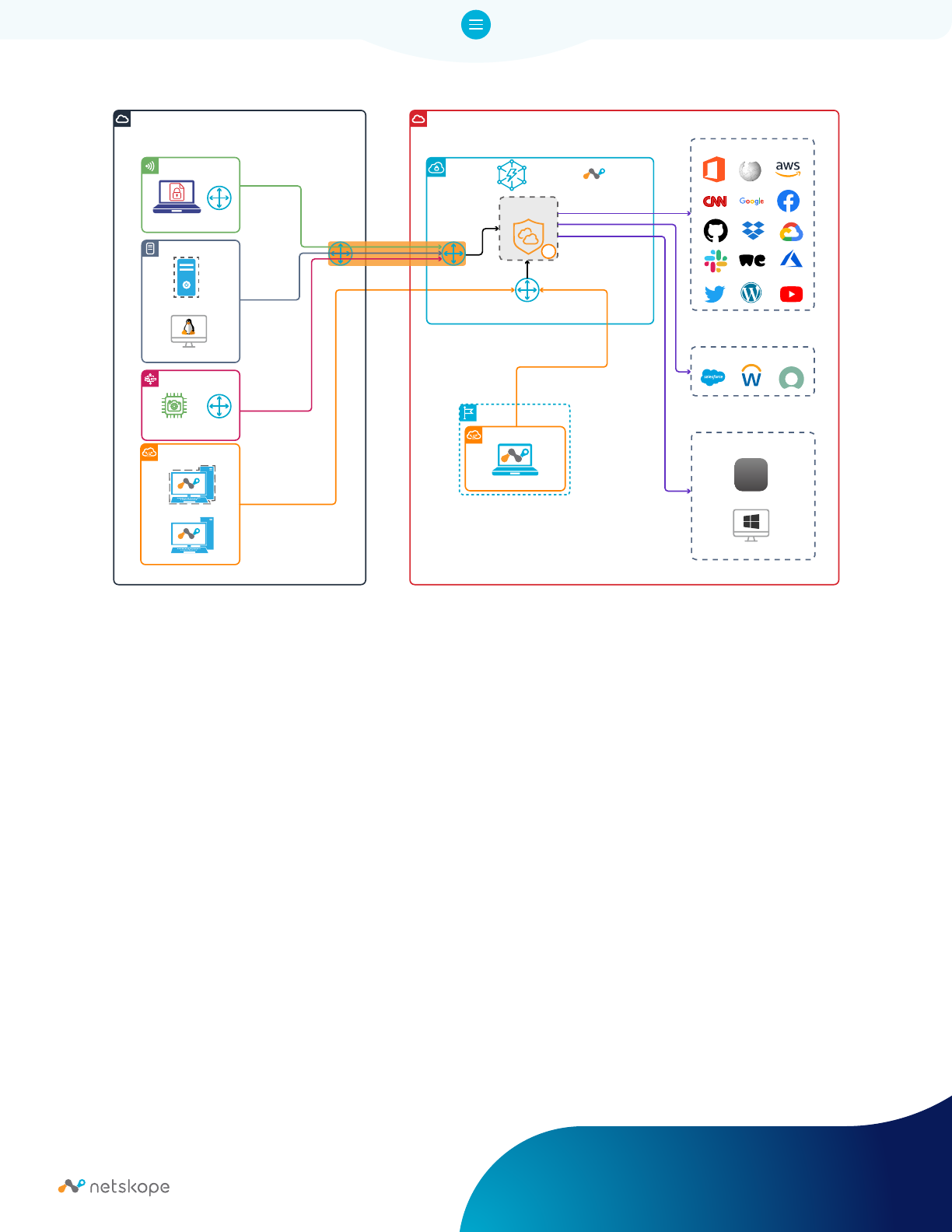
43
Figure 10: Netskope Dedicated IP Range
Beneits of DEIP
This option has the following beneits::
• It can be used as a broad security control to prevent users from accessing public Web and Cloud
applications when not traversing the Netskope SSE platform.
• It can be used in access control policies like Microsoft AzureAD (Entra AD) Conditional Access
Policies as an additional trust criteria for access of cloud apps or even speciic riskier operations..
• It forces users to enable/install the Netskope Client to access the application when roaming.
• Remove the need to backhaul application access to private datacenter just to leverage allowed
egress IPs, which can severely impact performance.
• Trafic traverses the Netskope SSE platform, therefore security controls are applied - Malware/
Threat, DLP, RBI.
• Netskope Cloud Firewall will use the same dedicated IP addresses for accessing Non-Web (TCP/
UDP) applications and ports.
• IP addresses are dedicated to the customer tenant for the life of the contract.
Customer Internet
IPSec / GRE
DTLS TLS Tunnel
HTTP / HTTPS
HTTP / HTTPS
Cloud / Web Apps
Non-Web Apps
IP Restricted Apps
Explicit Proxy
loT Trasparent
Trasparent
Laptop
Virtual Server
Unmanaged / Guest
Servers
Non-Proxy Aware
VM Linux
Data
Plane (DP)
TLS
NewEdge
Netskope
NS Client
Gateway
DTLS /TLS Tunnel
Tunel
Gateway
>
_
SSH
Figure 10: Netskope Dedicated IP Range
Managed Endpoints
Managed Endpoints
Remote
Virtual-PC
Laptop Device
PC
Dedicated Customer IP
Dedicated Customer IP
Dedicated Customer IP

44
ADDITIONAL RESOURCES
Videos
• Netskope: Flexible Deployment Options (5 minutes and 42 seconds)
https://www.youtube.com/watch?v=obRTgR8t6zk
• Netskope Location Awareness and Steering (3 minutes and 43 seconds)
https://www.youtube.com/watch?v=946KK43hzjE
Training
• Netskope Security Cloud Introductory Online Technical Training (4 hours, divided into 10 courses
~ average time to completion: 25 minutes)
https://www.netskope.com/training/netskope-security-cloud-introductory-online-technical-training
• Steering related Courses:
◦ Course 8: Introductory Technical Training: Deployment Options Overview—15 min
◦ Course 9: Introductory Technical Training: Netskope Out-of-Band Deployment Options—30 min
◦ Course 10: Introductory Technical Training: Netskope Inline Deployment Option—25 min
• To request an account, please email: training@netskope.com. Include the following: irst name,
last name, business email address, and business name.
Lab
• Self paced Hands on Lab (client steering method, 24 hours with 48 hour access)
https://www.netskope.com/company/events/intelligent-sse-hands-on-lab
Addendum
• Firewall Rules / Network ACLs
The Netskope Client requires direct connectivity to the Netskope Security Service Edge (SSE) for
the best possible performance. To allow the Netskope Client to connect directly to the Netskope
SSE, TCP & UDP 443 must be allowed through the irewall to the SSE network IP ranges referred
below. The Netskope Client uses HTTPS, TLS and DTLS protocols. Below are the IP ranges for the
Netskope SSE Global network.
Please refer to:
https://support.netskope.com/s/article/NewEdge-Consolidated-List-of-IPRange-for-Allowlisting
for the consolidated list of IP ranges of all NewEdge DCs.
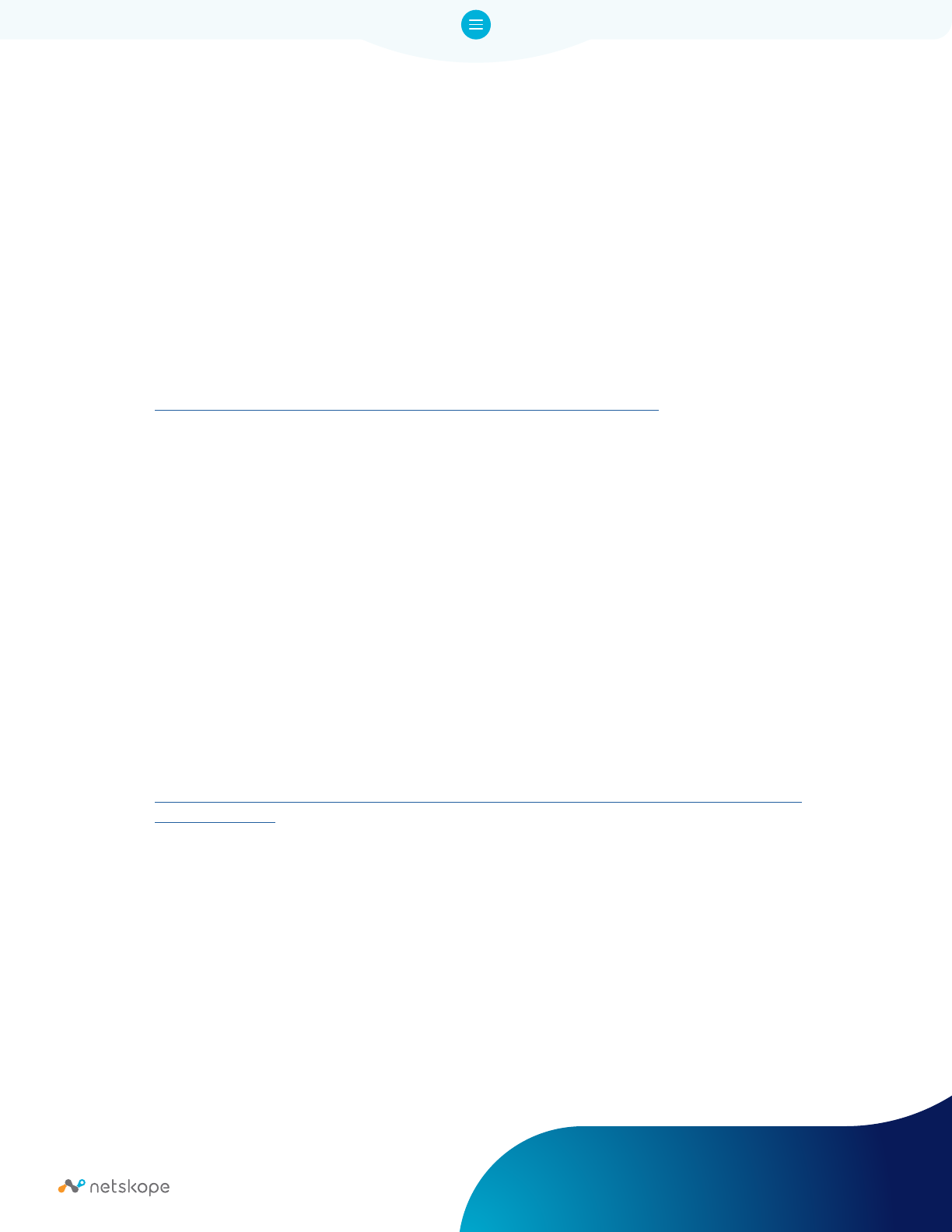
45
• Disable SSL Decryption/Inspection on Network Devices
SSL Decryption must be disabled on all irewalls or inspection devices for theNetskope Client to
connect to the Netskope Security Service Edge. The payload of Netskope Client tunnel uses a
proprietary framing protocol which other security tools would not be able to parse and inspect.
For additional security, Netskope Client also pins itself to Netskope-issued SSL certiicates to
ensure that security of the tunnel is not compromised or intercepted in any way.
• Endpoint Antivirus / Malware
A number of Netskope Client Folders, Files and Processes need to be added to endpoint antivirus/
malware applications to allow the Netskope Client to run and connect to Netskope SSE.
Please follow the best practice recommendations from:
https://docs.netskope.com/en/exceptions-for-anti-virus-applications.html
• Security Enforcements
Password protection for uninstallation is supported on Windows, macOS and Linux. Preventing
service stop using this password is only supported on Windows.
Protect Client coniguration and resources is Windows only - Prevent users from tampering
with the Netskope Client process, coniguration iles, registry, and directory location.
• Network Detection
Dynamic steering enables location-based steering capabilities via on-premises or off-premises.
Depending on the location, you can set up the steering coniguration to steer or bypass conigured
trafic. When a managed device is detected to be on-premises, only cloud applications are steered
and when the device is detected to be off-premises, all web trafic is steered. Dynamic steering
also extends the capability to steer trafic from all or speciic private applications.
More information here:
https://docs.netskope.com/en/netskope-help/trafic-steering/steering-coniguration/enabling-
dynamic-steering

46
• Fail Close
Activating the "Fail Close" setting will concurrently activate "Password protection for client
uninstallation and service stop." Additionally, it will deactivate the options for "Allow disabling
of Private Apps Access" and "Allow disabling of clients."
In simpler terms, turning on "Fail Close" not only secures the uninstallation and service stop
processes with a password but also prevents the disabling of Private Apps Access and clients.
• SSL TLS Inspection
SSL decryption policies are applied right after the trafic is steered to Netskope. By default,
all trafic steered to Netskope will be decrypted, then further analyzed via Real-time
Protection policies.
If there is any trafic that you would like to leave encrypted, such as anonymous guest trafic
and private inancial/medical trafic, you can specify them in the Management UI, SSL
Decryption Policies.

Netskope, a global SASE leader, is redeining cloud, data, and network security to help organizations apply zero trust principles
to protect data. Fast and easy to use, the Netskope platform provides optimized access and real-time security for people, devices,
and data anywhere they go. Netskope helps customers reduce risk, accelerate performance, and get unrivalled visibility into any cloud,
web, and private application activity. Thousands of customers, including more than 25 of the Fortune 100, trust Netskope and
its powerful NewEdge network to address evolving threats, new risks, technology shifts, organizational and network changes,
and new regulatory requirements.
Learn how Netskope helps customers be ready for anything on their SASE journey, visit netskope.com.
©2024 Netskope, Inc. All rights reserved. Netskope is a registered trademark and Netskope Active, Netskope Cloud XD, Netskope Discovery, Cloud
Conidence Index, and SkopeSights are trademarks of Netskope, Inc. All other trademarks are trademarks of their respective owners. 1/24 RA7091
